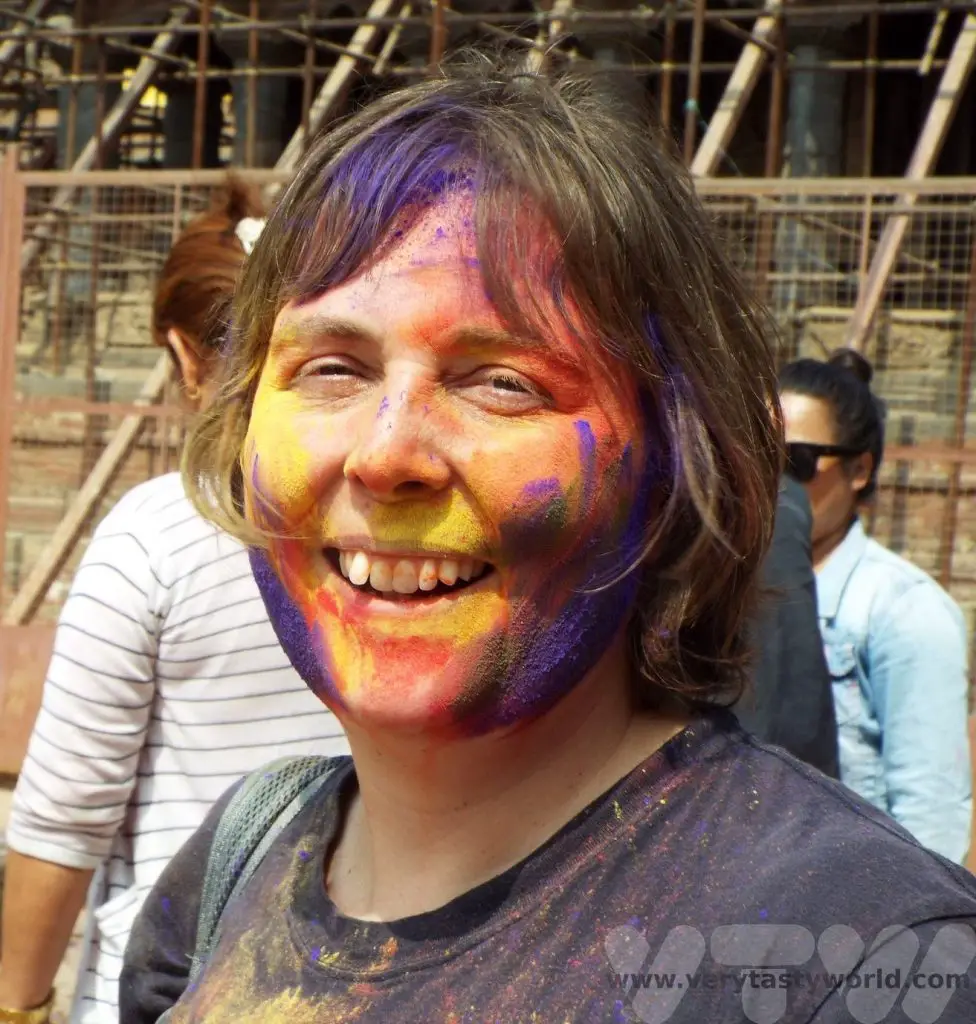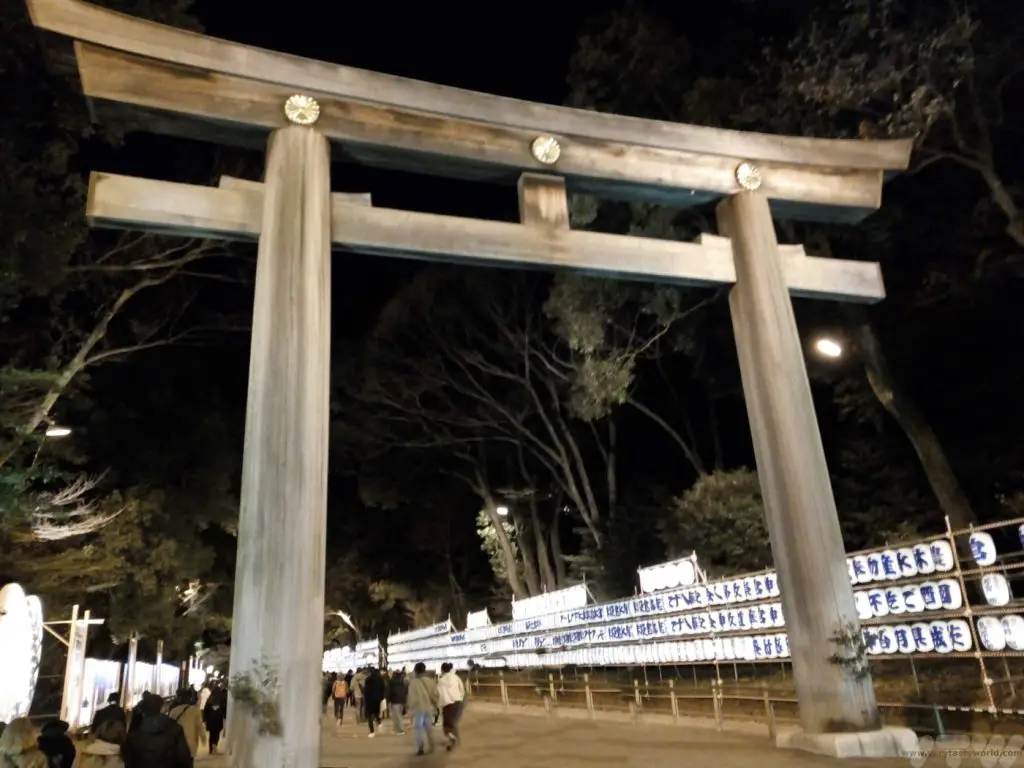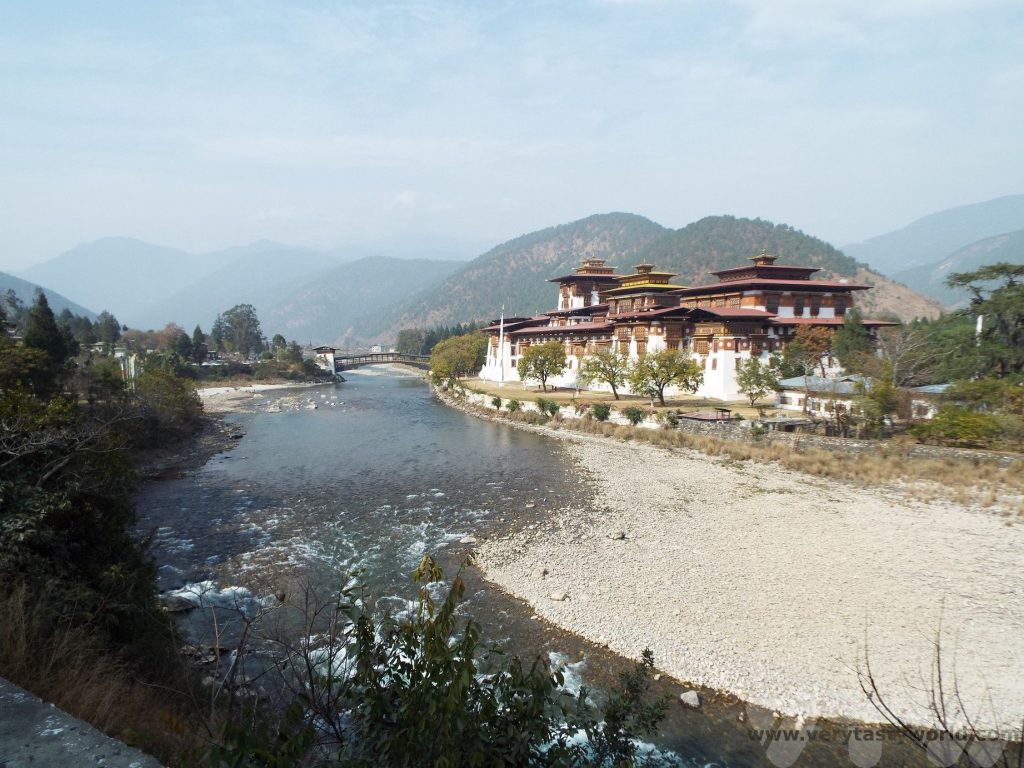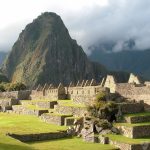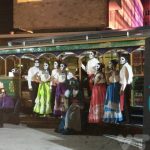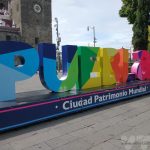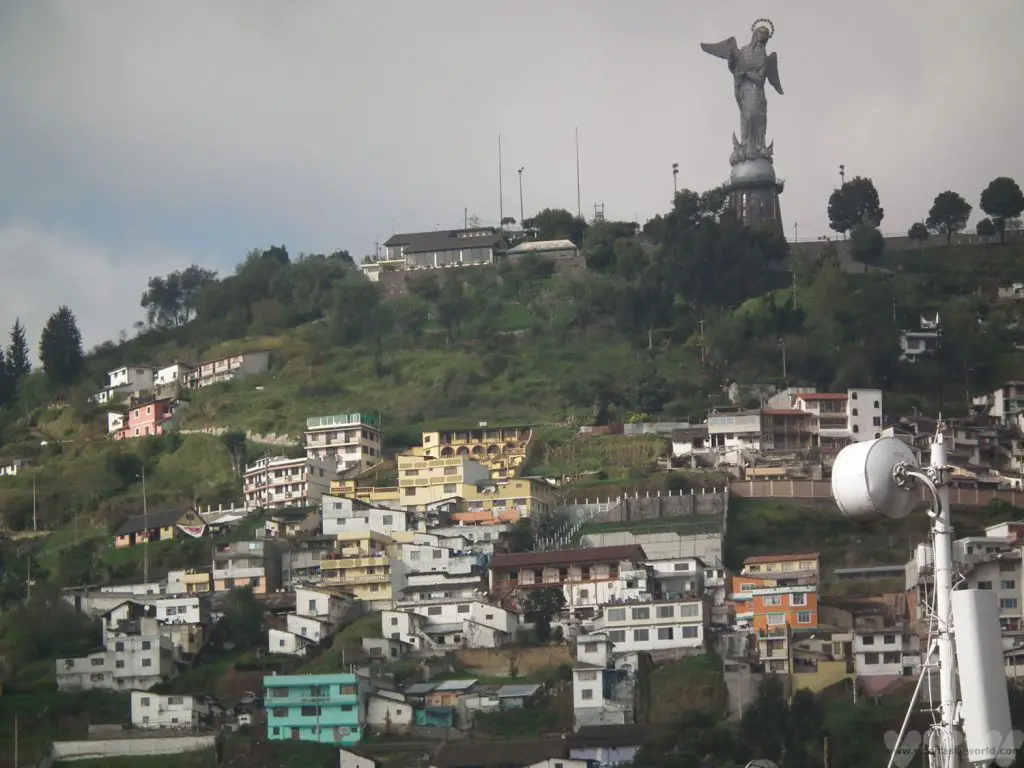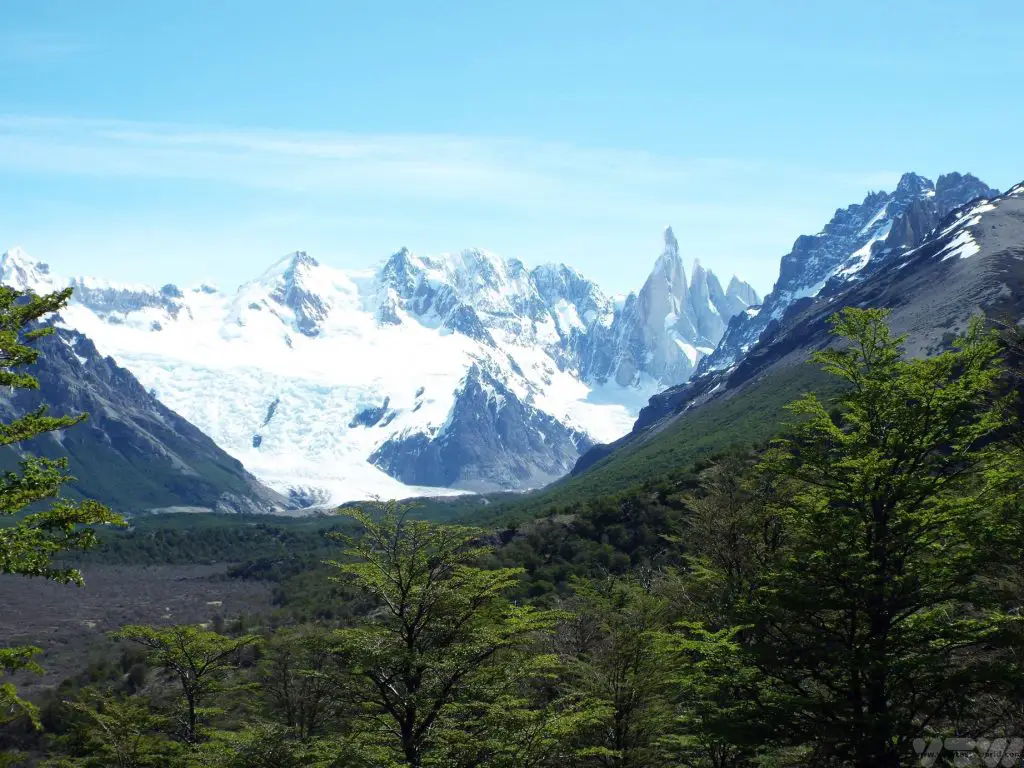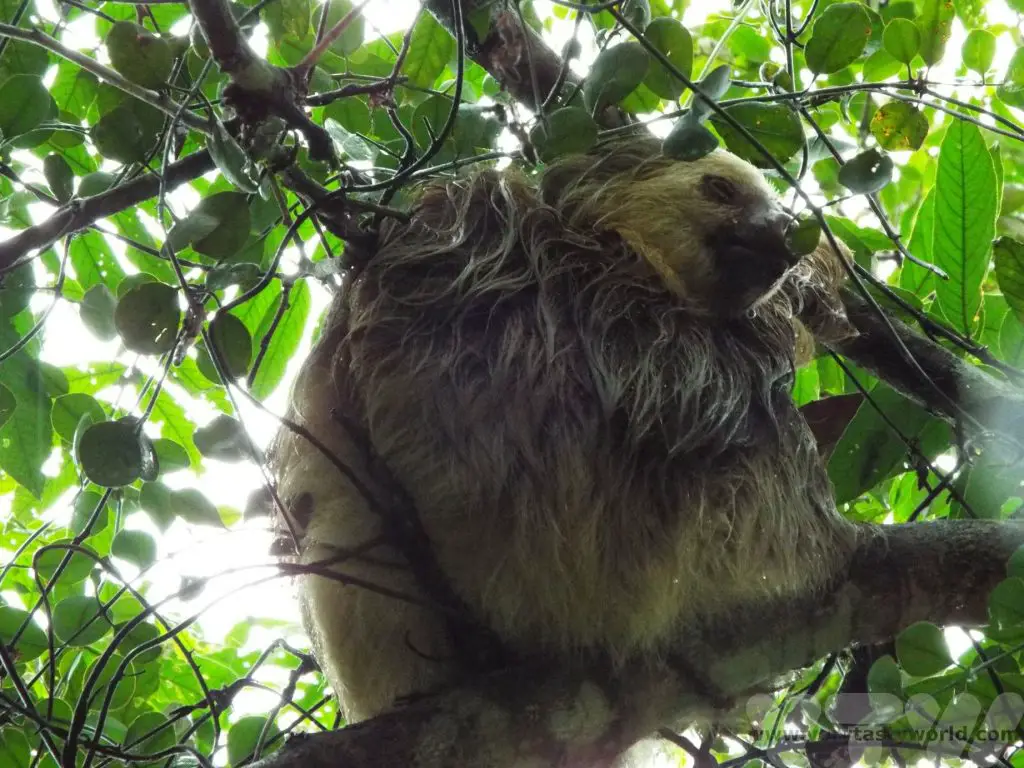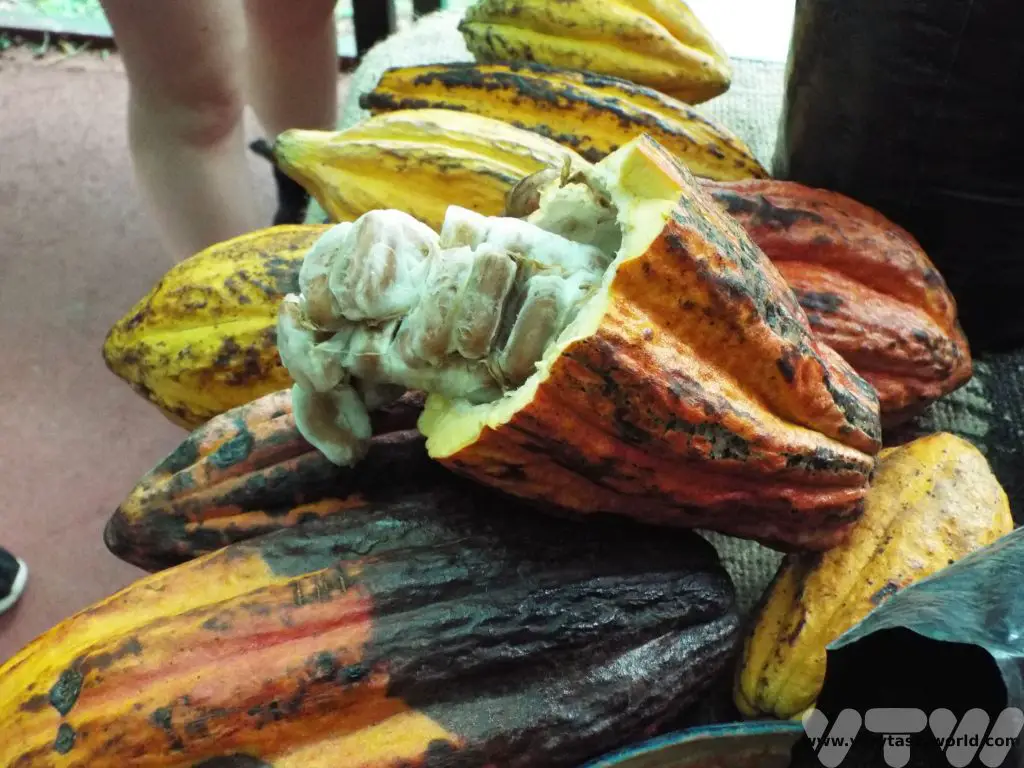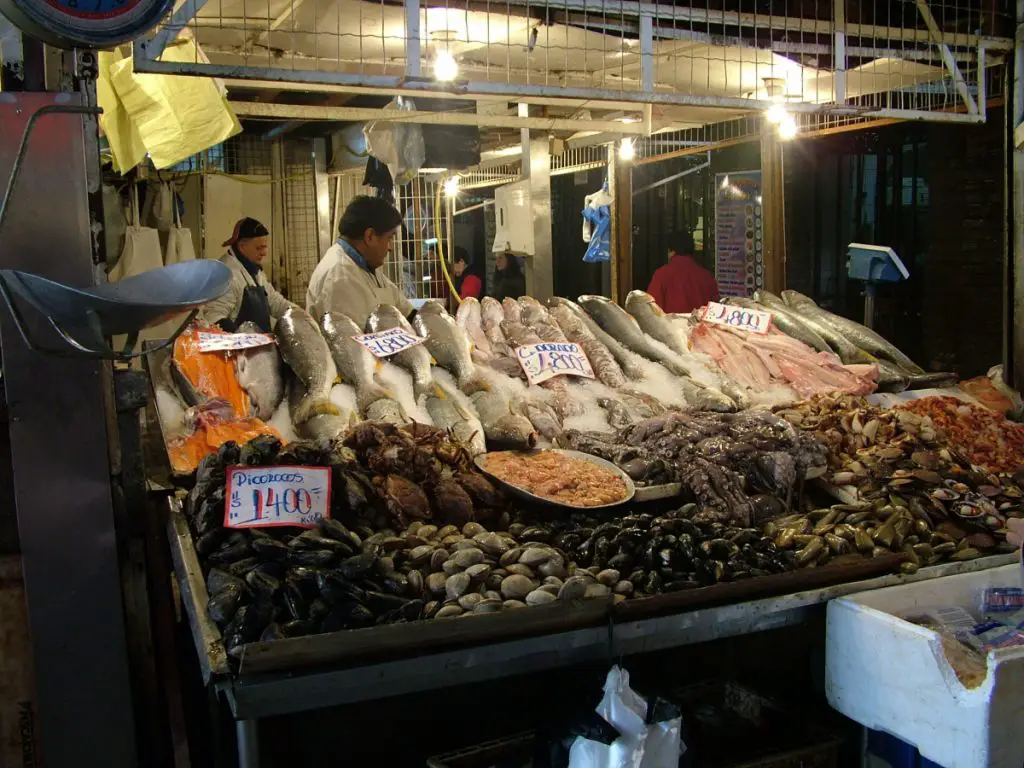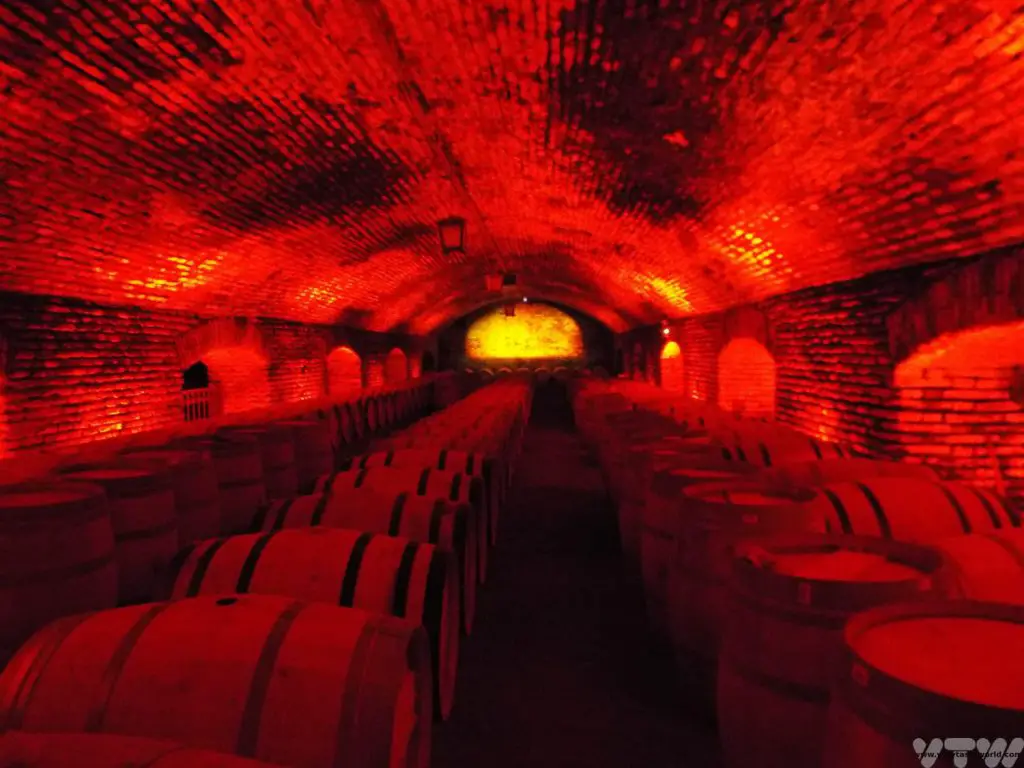Day of the Dead in Campeche
Our trip to Mexico was a long time coming. Originally planned for March 2020, we had to cancel the trip a week before we were due to fly, due to the pandemic, and rearranged for November 2020. And then cancelled that due to the pandemic. Finally, we managed to make the trip two and a half years later. But we decided to time the new journey to coincide with Mexico’s Day of the Dead – Dia de los Muertos – celebration which takes place in late October/early November and are very glad that we did. We were to spend Day of The Dead in Campeche.
We travelled on buses through Mexico, starting in Mexico City, visiting Puebla, Oaxaca, San Christobal, and Palenque before arriving in Campeche. The journey then proceeded to Merida, Chichen Itza and finally Cancun. Bus journeys are cheap and convenient but distances can be long.
Campeche is around six hours from Palenque or just a couple of hours from Merida if you are travelling on the bus.
Welcome to Campeche – Aaaarrrr!
Campeche is the capital city of the state of Campeche and lies on the Gulf of Mexico looking out over the azure sea. It is known for its colourful city centre and history of piracy.

History of Campeche
Campeche’s name derives from the Mayan phrase, Ah-Kin-Pech, which apparently means ‘the place of snakes and ticks’, which doesn’t sound at all inviting. We can confirm that no snakes or ticks were encountered during our visit.
The Spanish landed at Campeche in 1517 on St Lazarus’s day – the 29th July – and named the location Lazarus. The conquistadors began their occupation of the Yucatan peninsula, consolidating it in 1541-2, when they founded the first enduring Spanish councils at Campeche and Merida. Due to its coastal location Campeche became an important port. Valuable goods such as gold and silver passed through the town but, because of this, it became a target for local pirates. In 1663 the Sack of Campeche, led by pirates Christophe Myngs and Edward Mansvelt, involved a mass of pirates from around the Caribbean who got together some 14 ships and 1400 men and plundered the port.
In 1685 Dutch pirate Laurens de Graaf launched an attack on the city and killed a significant proportion of the population. As a result of these horrific raids, the authorities decided to fortify the central zone and built an extensive wall around it.
Campeche became recognised as a city in 1744, the first in the region. The community developed something of a rivalry with those in nearby Merida, although both cities eventually worked together to try to form an independent state of Yucatan. However, they were integrated into Mexico in 1849.
Campeche’s fortunes have waxed and waned over the years. The city is incredibly photogenic with its well-preserved colourful buildings and pirate legacy and as a result it has attained UNESCO status. It isn’t one of the most popular destinations for tourists, partly because there are many other places to visit on the Yucatan peninsular, but we recommend spending some time in Campeche if you get a chance.
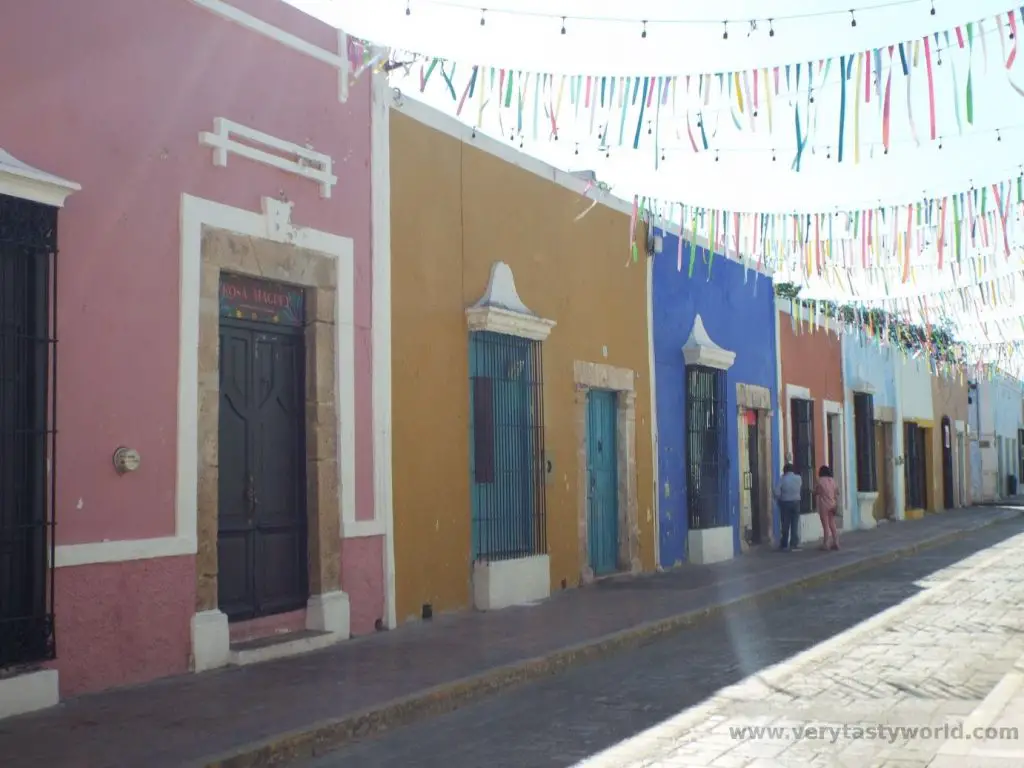
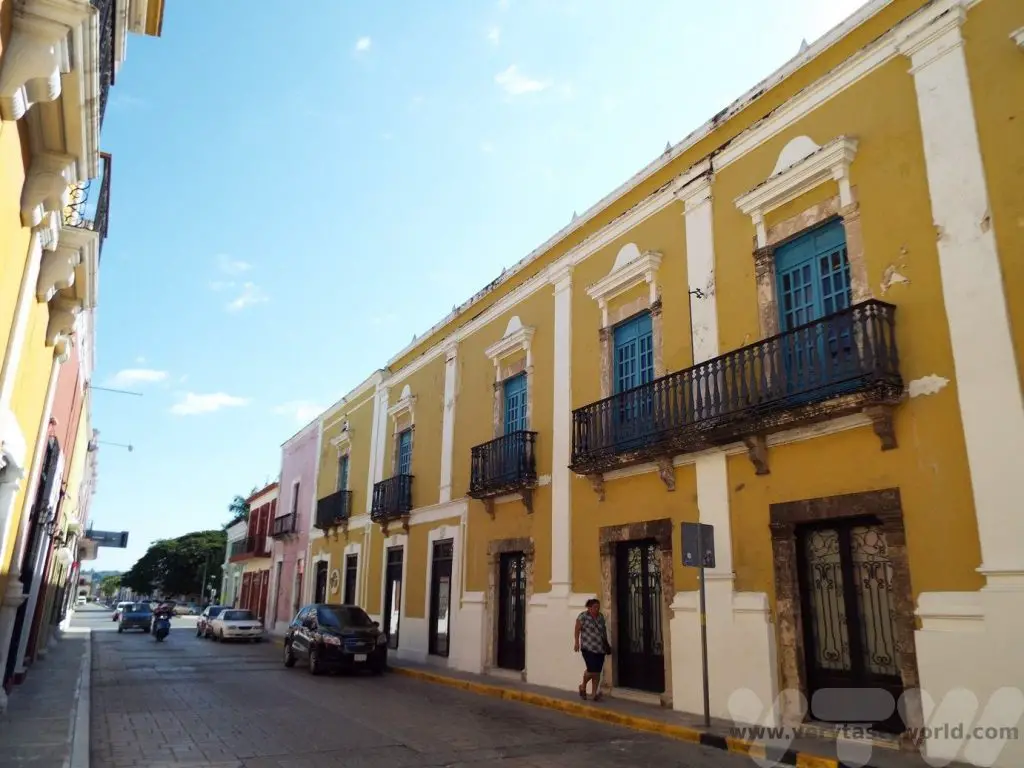
Things to Do in Campeche
There are plenty of walking opportunities, whether strolling along the Malecon walkway, looking out to sea, taking in the sights from the top of the fortified walls, or wandering through the colourful streets.
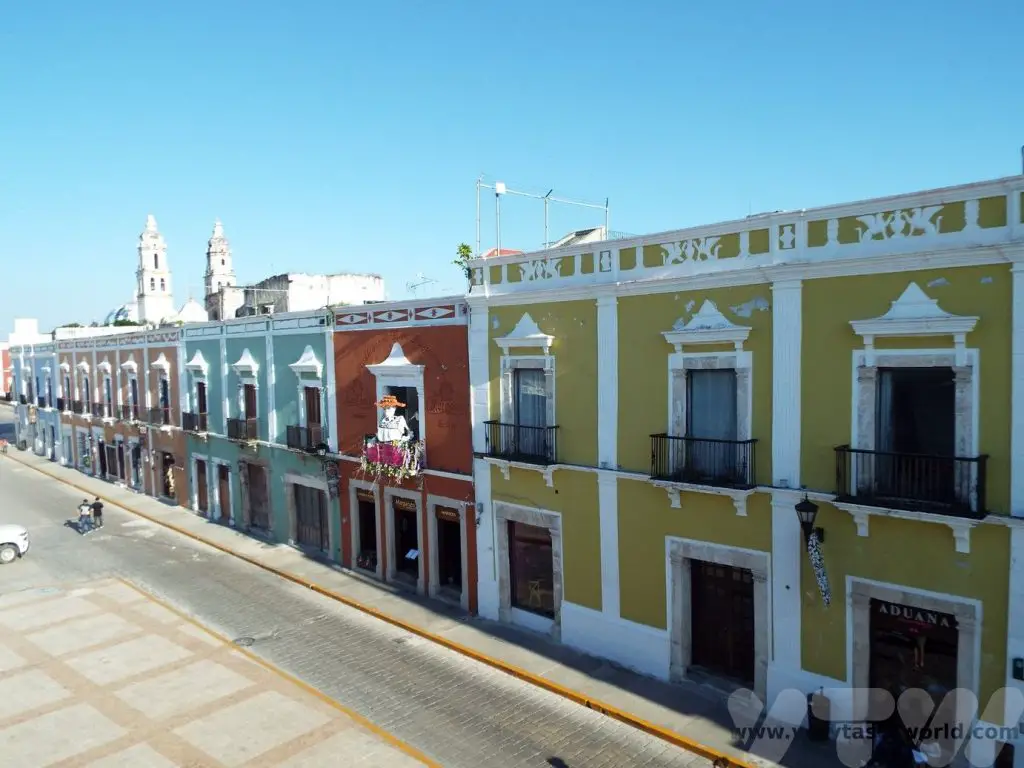

As well as walking along the walls, there are a couple of museums located in two of the bastions which are located at opposite ends of the wall closest to the sea.
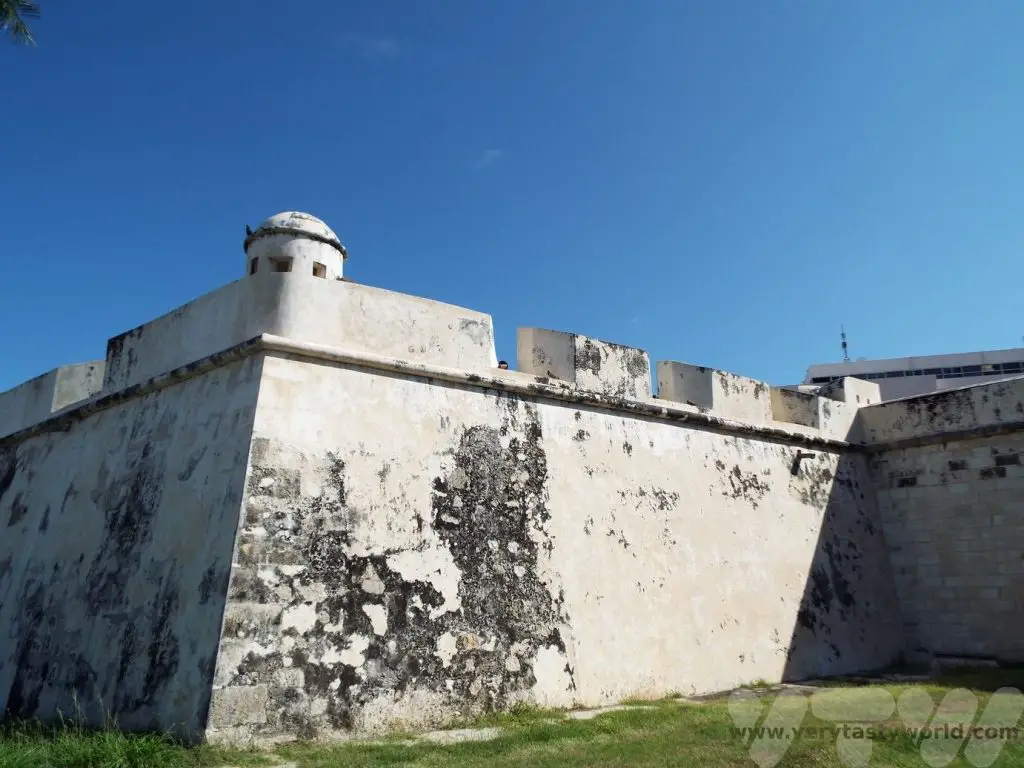
As with many cities, we find the tourist information centre to be a useful source to discover the local attractions. The friendly staff were happy to help us get acquainted with Campeche and suggested places to visit.
Pirate Museum
Documenting Campeche’s history as a port city, this small museum showcases information and artefacts with a focus on understanding its fortunes at the hands of the pirates over the years.
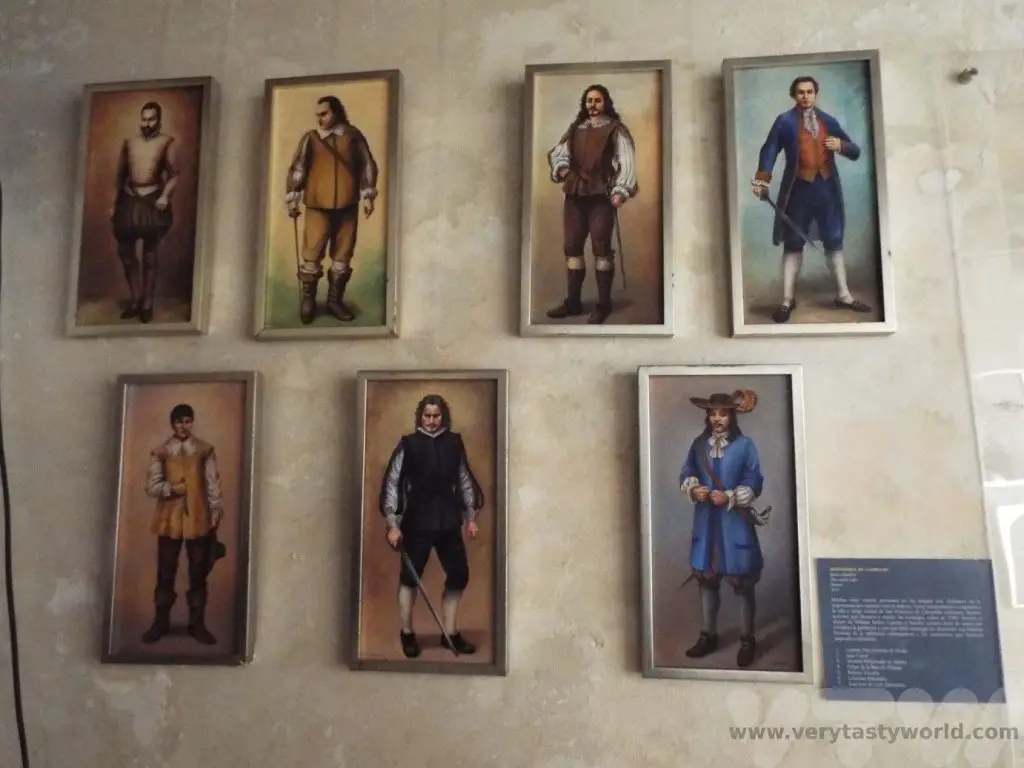
It is a very honest exhibition and dispels some of the romantic myths about pirates and piracy. Although films such as Pirates of the Caribbean have given us the impression of swashbuckling buccaneers, the real pirates who attacked Campeche were often society’s outcasts – marginalised and brutal.
Interestingly, Sir Francis Drake, viewed by the English as a heroic explorer who circumnavigated the globe, was despised by the Spanish as a ‘privateer’, a person who engaged in maritime conflict. Although perhaps it’s not really that surprising – the English and Spanish were fierce enemies at that time and many of the attacks by pirates were sanctioned by the state as ‘commerce raiders’ to undermine Spanish authority in this region.
And, naturally, the museum has a bunch of creepy mannequins in the dungeon.
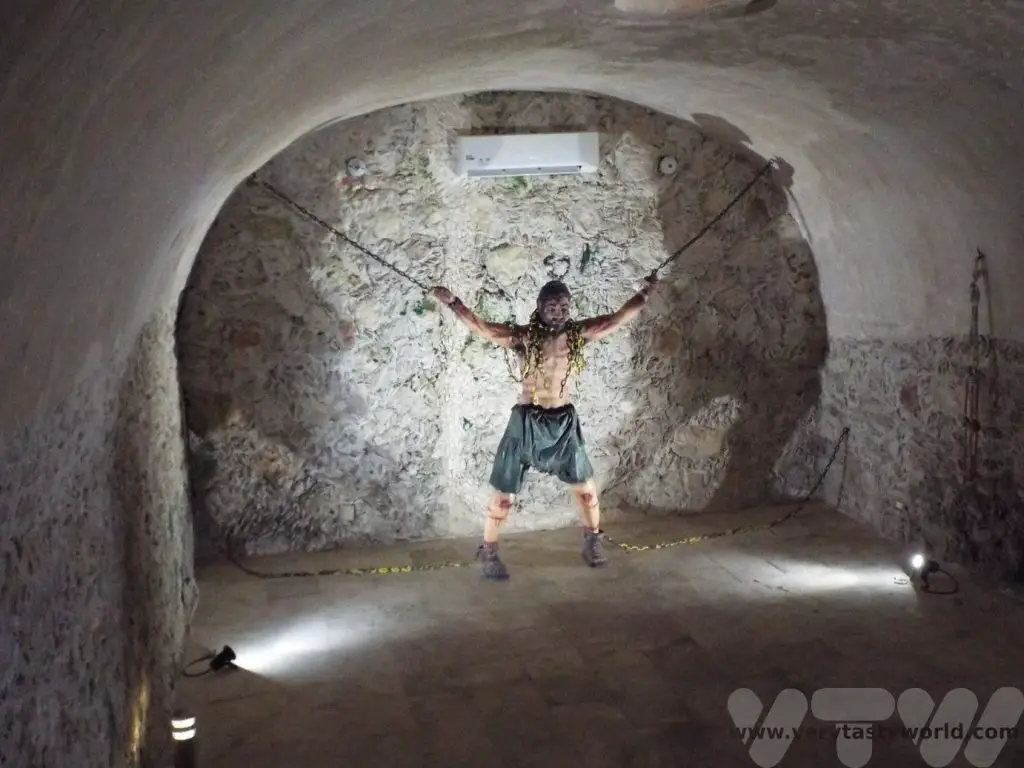
Don’t forget to head out to the city walls where you can see some of the cannon that defended Campeche.
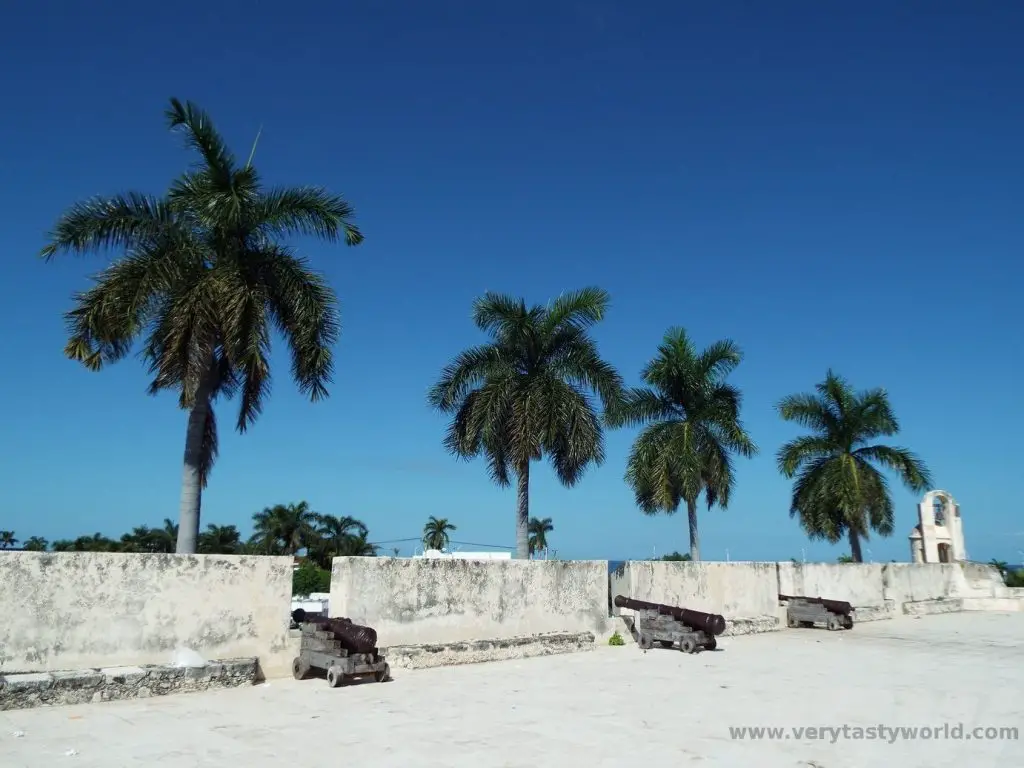
Museo de La Arquitectura Maya
This small but interesting museum on Baluarte de la Soledad houses a number of archaeological artefacts that have been found in the region. Exhibits are in English and Spanish. It was particularly interesting to learn about the writing systems of the Mayan people.
The highlight exhibit is the elaborate and beautiful mask of the God K’wiil.
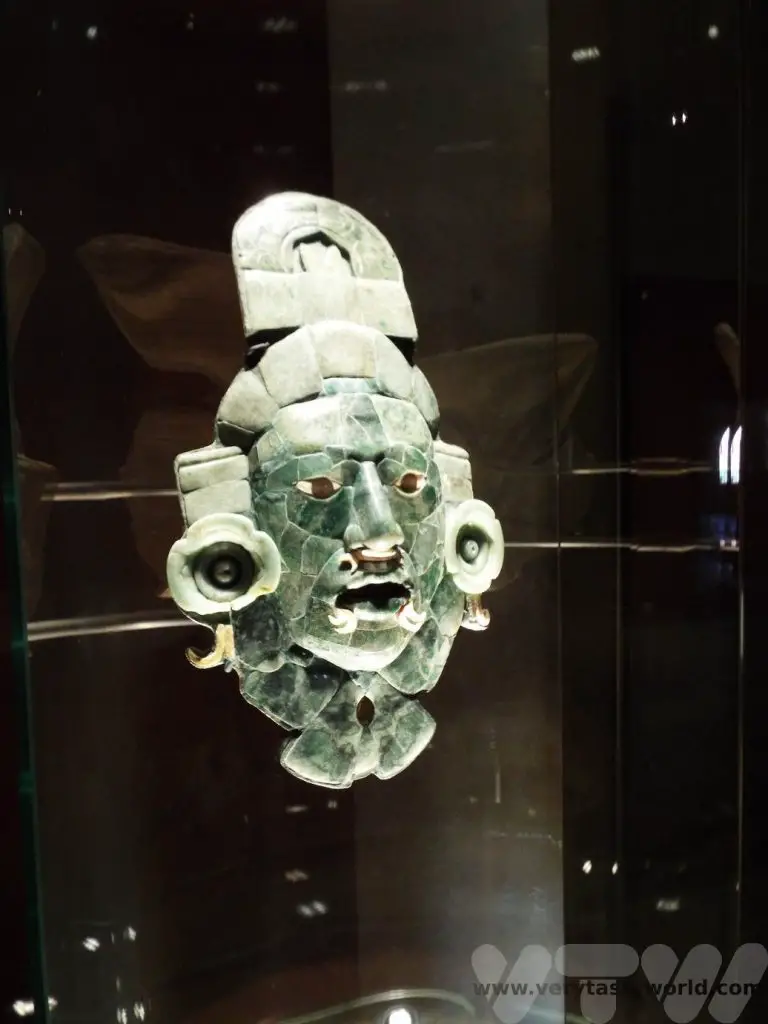
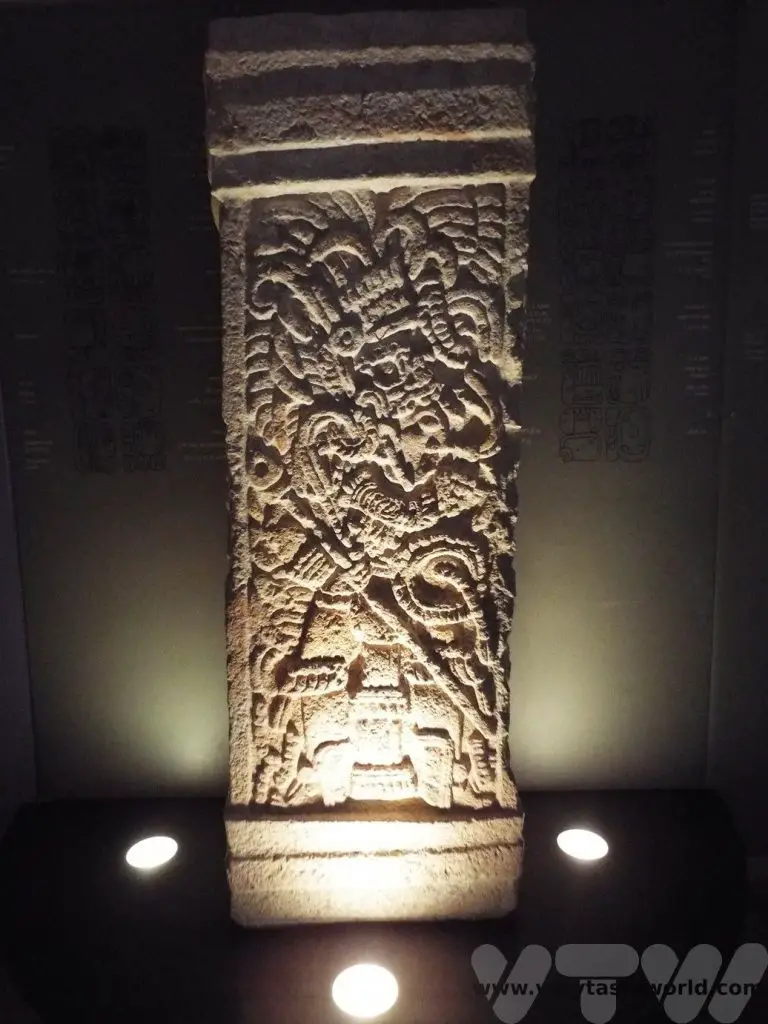
Make sure you climb up onto the wall at the end of your visit to get some fantastic views of the city in one direction and the Gulf of Mexico in the other.
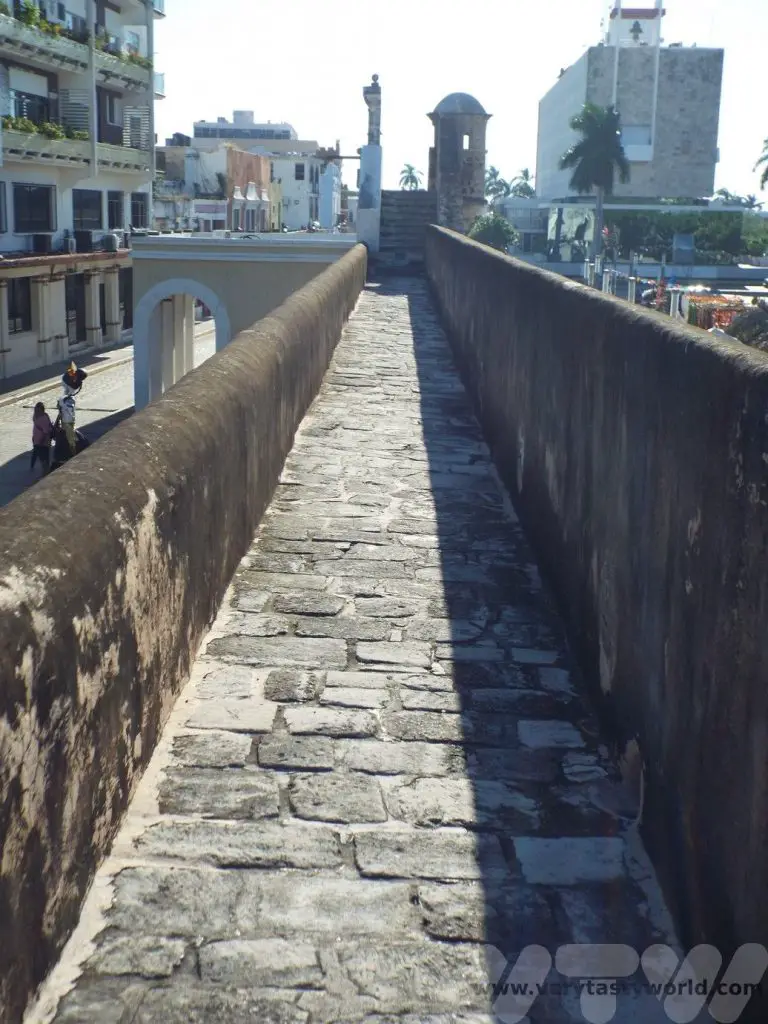
The Cathedral
The cathedral is located at the eastern end of the Plaza de la Independencia and is the most important church in the city. Construction started in the 16th century, soon after the Spanish settlers arrived. The cathedral has been expanded and embellished over the centuries. It has two impressive bell towers and a stone façade.
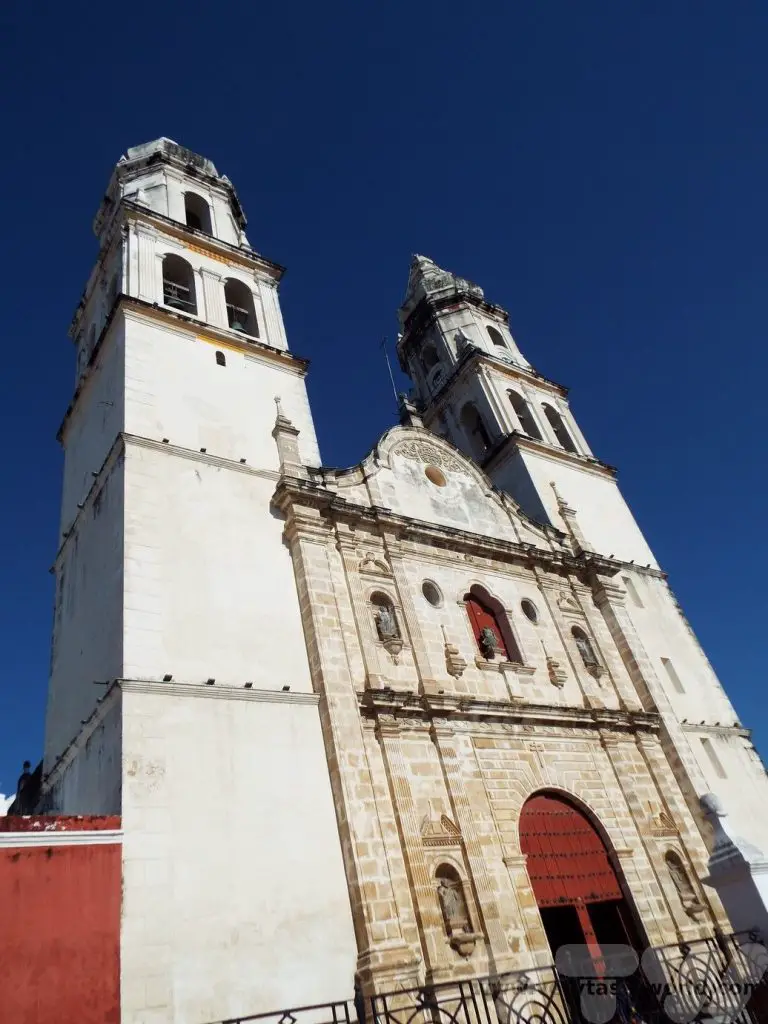
The Sea Promenade
With its location right on the Gulf of Mexico Campeche’s seafront doesn’t have pristine sandy beaches, so isn’t ideal as a seaside destination. But Malecon de Campeche offers a 7km waterfront path and makes for a lovely walk looking out to the deep blue sea.
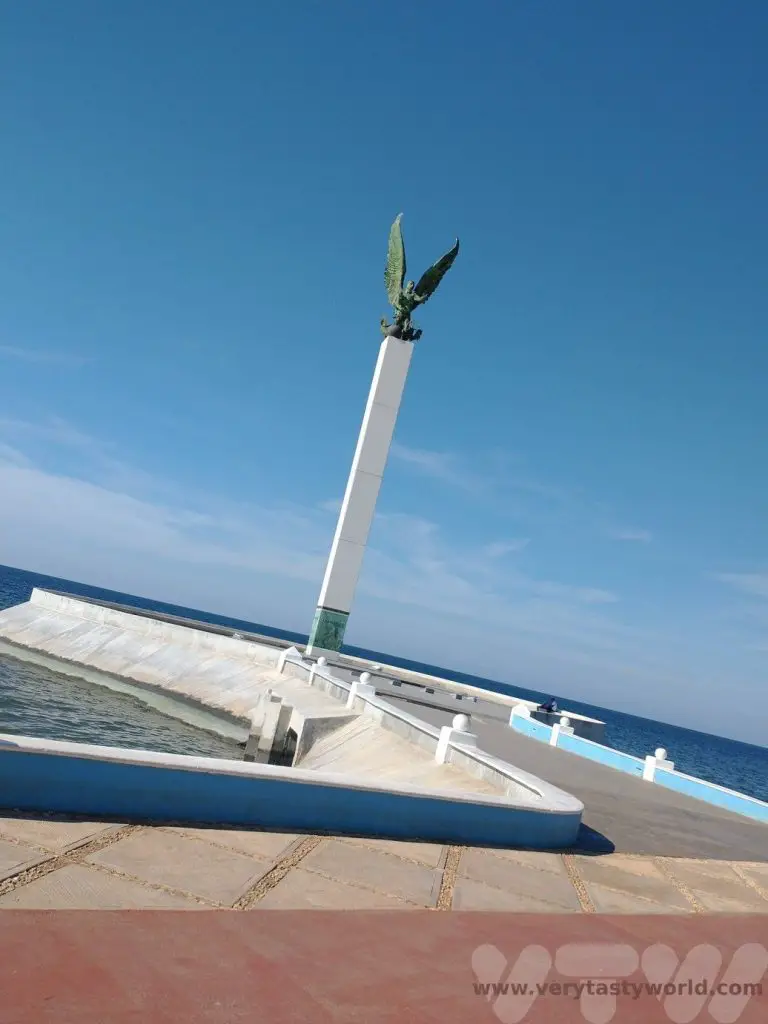
Campeche Food
Being located right on the coast there is plenty of seafood to enjoy in Campeche. Prawns are very popular. There are plenty of restaurants in the zona centro to choose from.
We enjoyed battered prawns with coconut and mango salsa and prawns with x’catic sauce. X’catic are a type of chilli which are long and thin and a pale green colour when ripe. They are commonly used in the Yucatan area and one of the specialities is x’catic in a cream sauce. While the chillies have a kick, the cream sauce mitigates some of the heat. And the sauce has an unusual blue-green colour.
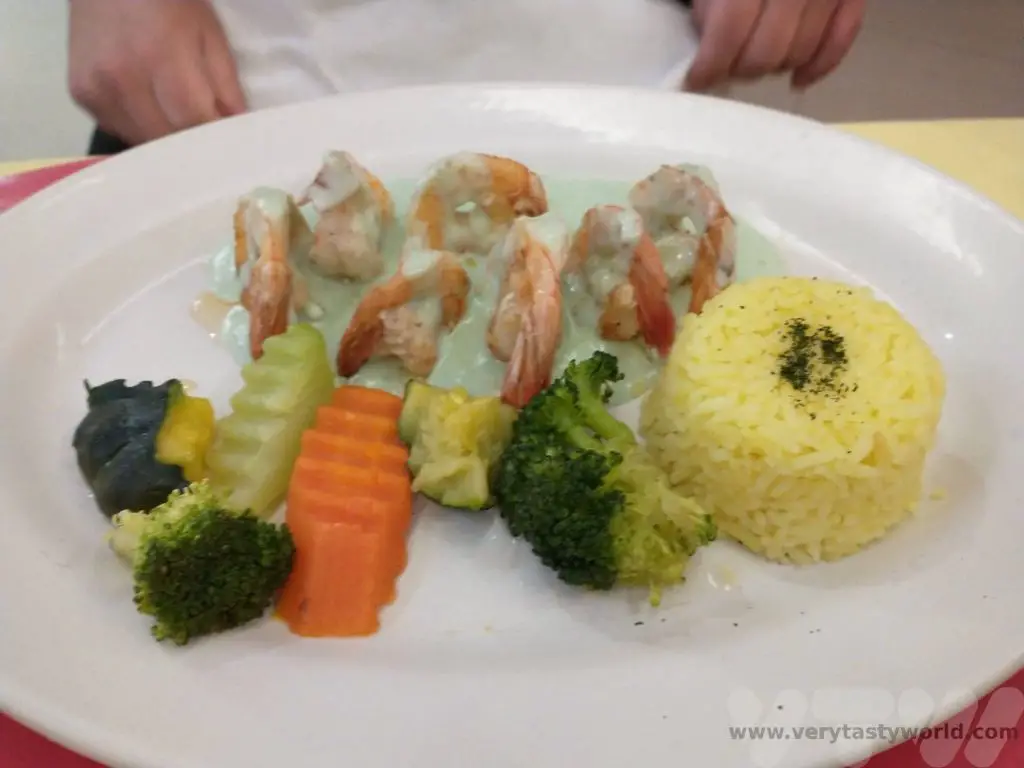
Day of the Dead in Campeche
We were lucky to be visiting Campeche during the Day of the Dead. This festival takes place on the 1st and 2nd November each year but preparations for the celebrations start much earlier and it is likely that the famous Day of the Dead parades will take place on the Saturday or Sunday before.
Day of the Dead is a celebration for families to remember and commemorate the lives of their ancestors. The origins are slightly unclear but it is thought that they are a combination of the indigenous commemorations of ancestors with Christian traditions; the timing of the celebration aligns with Halloween/All Saint’s Day. The Mayan people believe that death is simply another element of life.
In the time leading up to Day of the Dead relatives will visit the graves of their ancestors and will tidy them and prepare for the festival. Some may even exhume the skeletons of their relatives to clean their bones for up to three years after death. Food will be offered to invite their loved ones to visit. The dead will arrive on the 1st November and return the following day.
Day of The Dead Ofrenda
In the days leading up to the celebration, families and businesses will set up ofrenda. These are like alters which are highly decorated and lay out offerings to invite their deceased relatives to visit them.
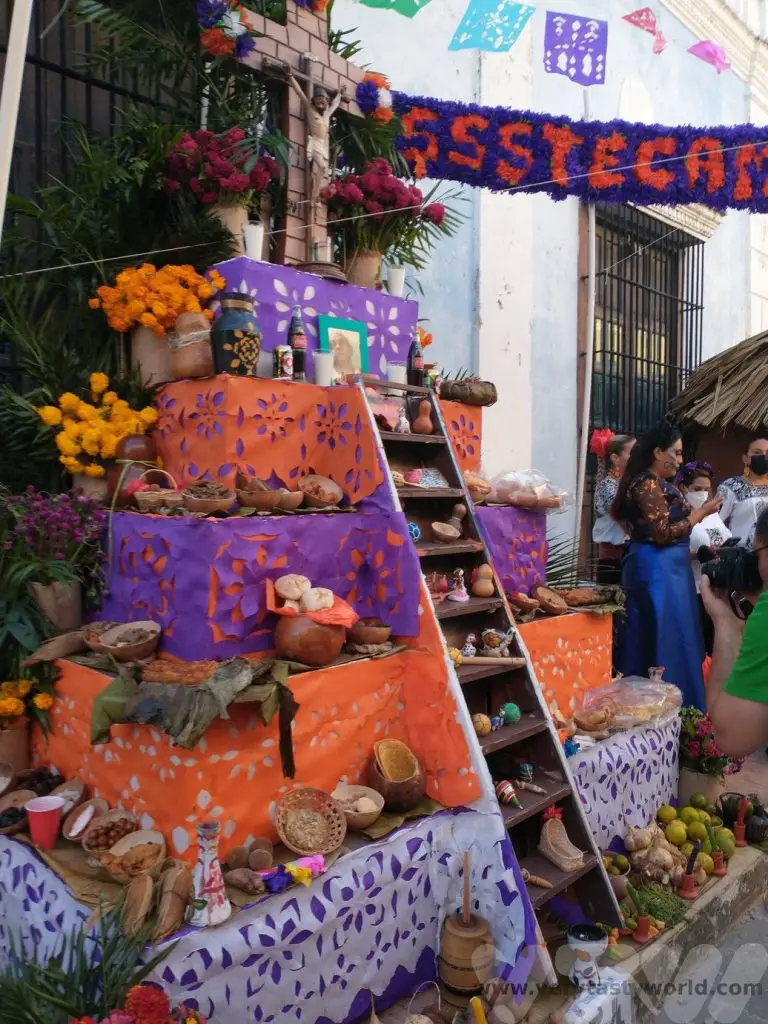
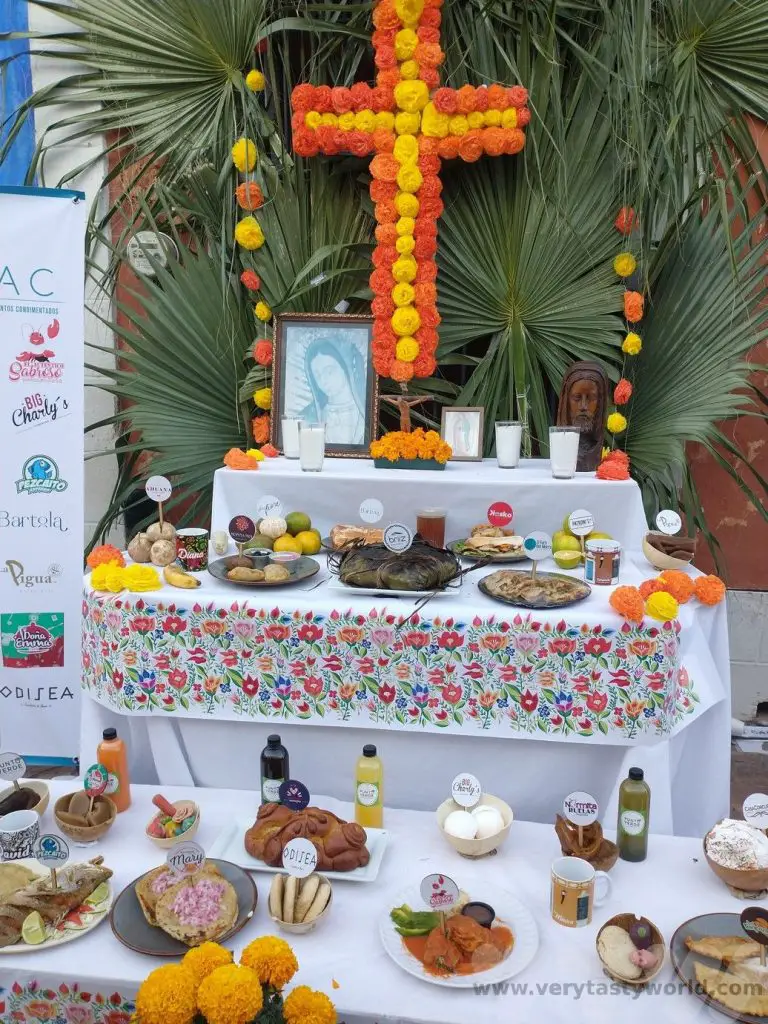
The food offered is real but it is rotated every day and replaced with new offerings. The previous day’s items are eaten by the family so as to ensure that food doesn’t go to waste.
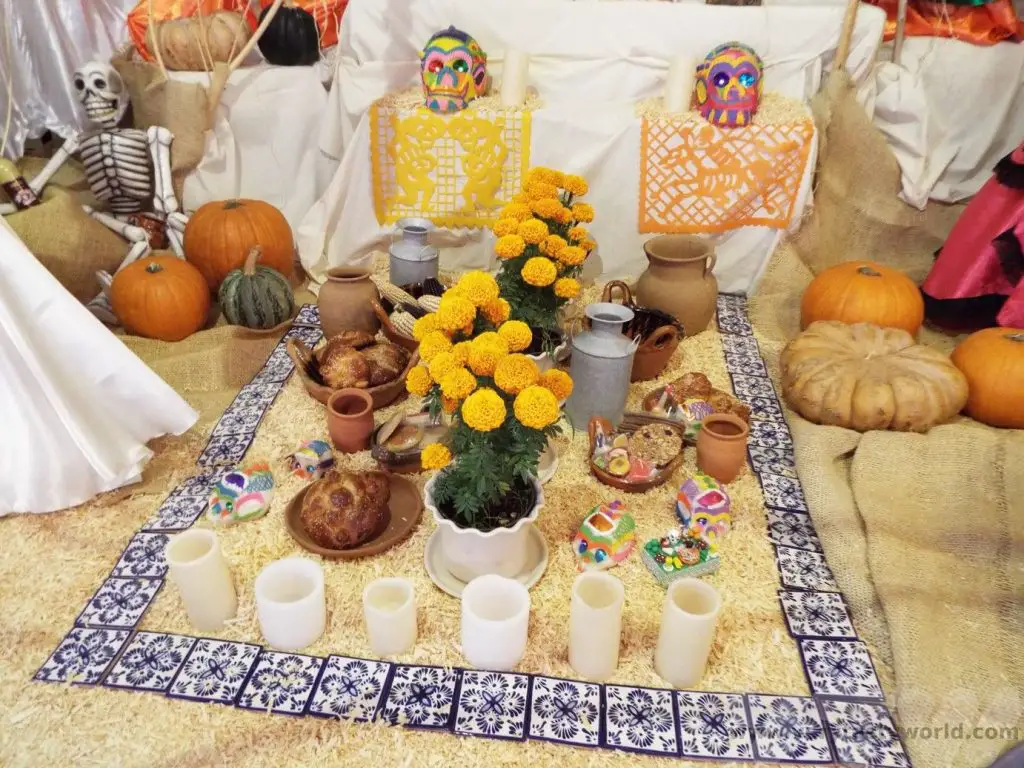
There is special Day of the Dead bread, known as Pan de Muertos. The central bread roll represents a skull and the surrounding sections of the bread symbolise the rest of the body.
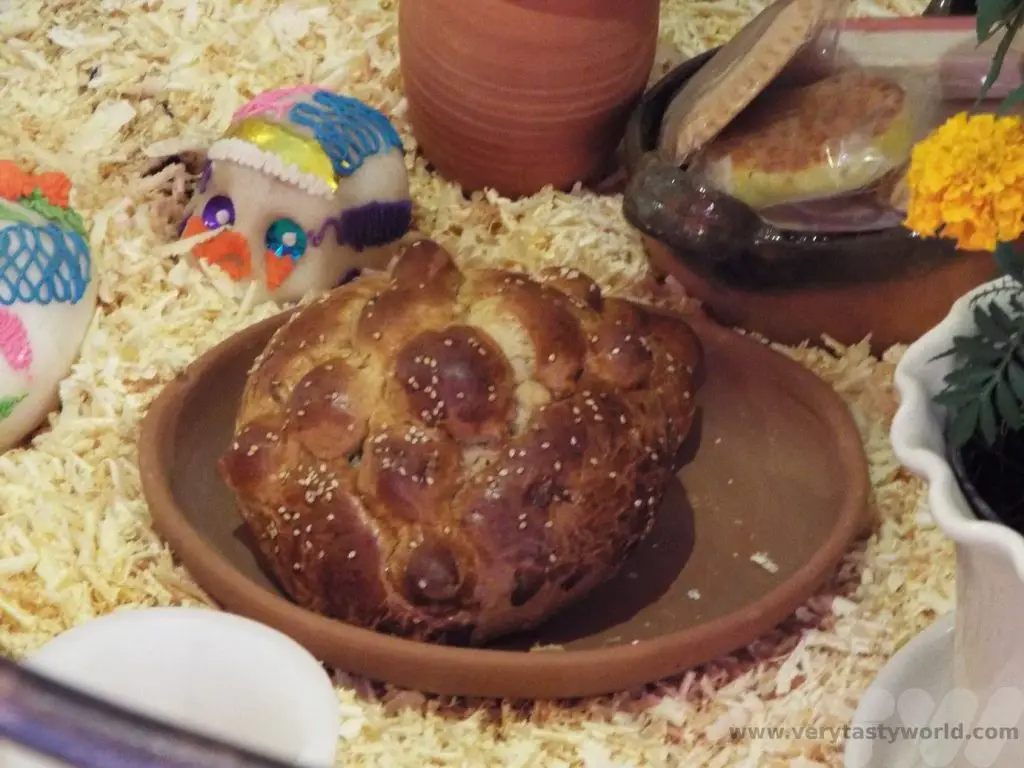
Marigolds are an essential part of the ofrenda. We saw fields of marigolds as we travelled through Mexico. The flower represents the fragility of life and its orange hue provides a colourful addition to the ofrenda.
Additionally, photos of ancestors may well be on display. And ofrenda are not restricted to humans. People also remember their pets and offerings are made for those as well.
Sugar skulls are a traditional sweet eaten during the festival. These are pure sugar but it is possible to buy chocolate ones as well. They make lovely souvenirs.
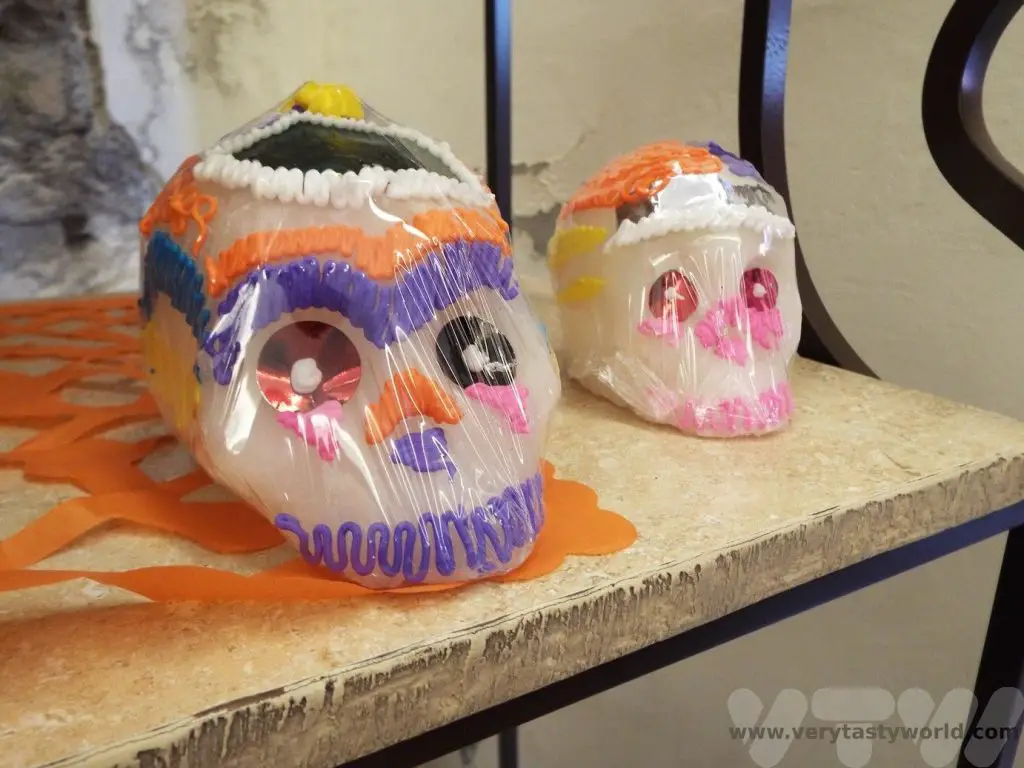
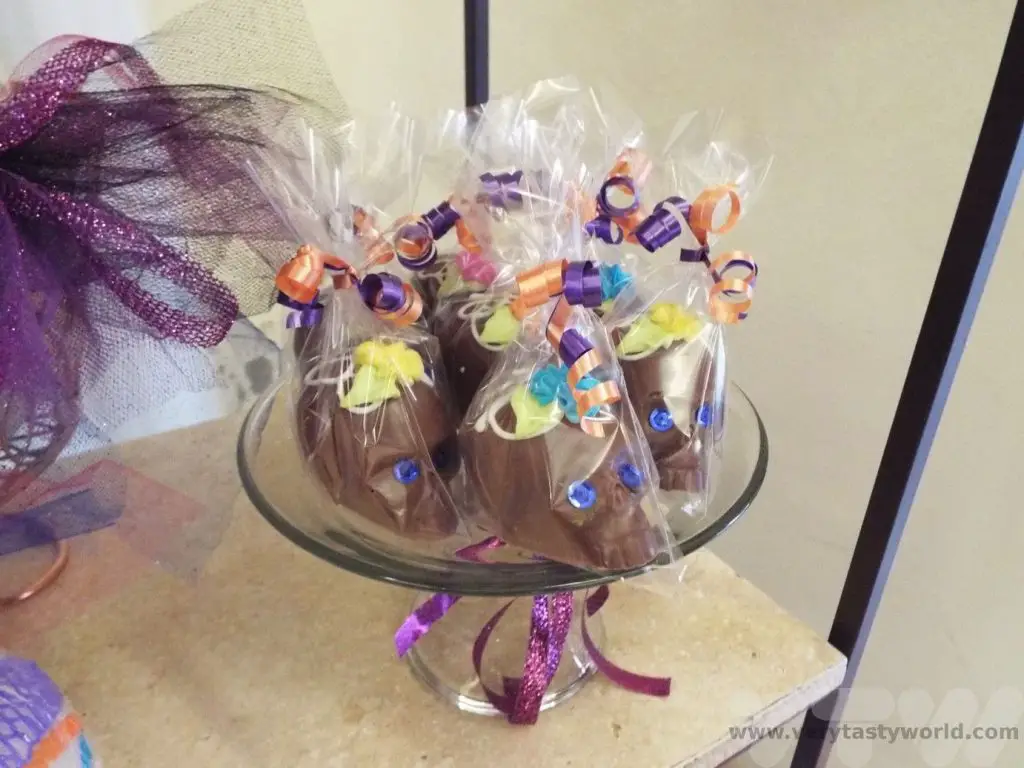
Day of the Dead in Campeche – The Celebration
Throughout our journey across Mexico in the days leading up to Day of the Dead, we would see homes and businesses preparing for the celebration. Every hotel and restaurant had decorations and ofrenda set up.
The parades in the big cities such as Merida or Oaxaca are very famous and will generally draw large crowds. We were actually delighted that we were able to join the celebrations in a smaller city. Later on, in Merida, we were able to see further ofrenda and some more celebrations but the main parade was in Campeche.
We arrived on the bus in the late morning and made our way to Calle 59 to get our bearings. This is the main street that is usually buzzing with bars and restaurants but during the afternoon we were able to see the ofrenda being set up.
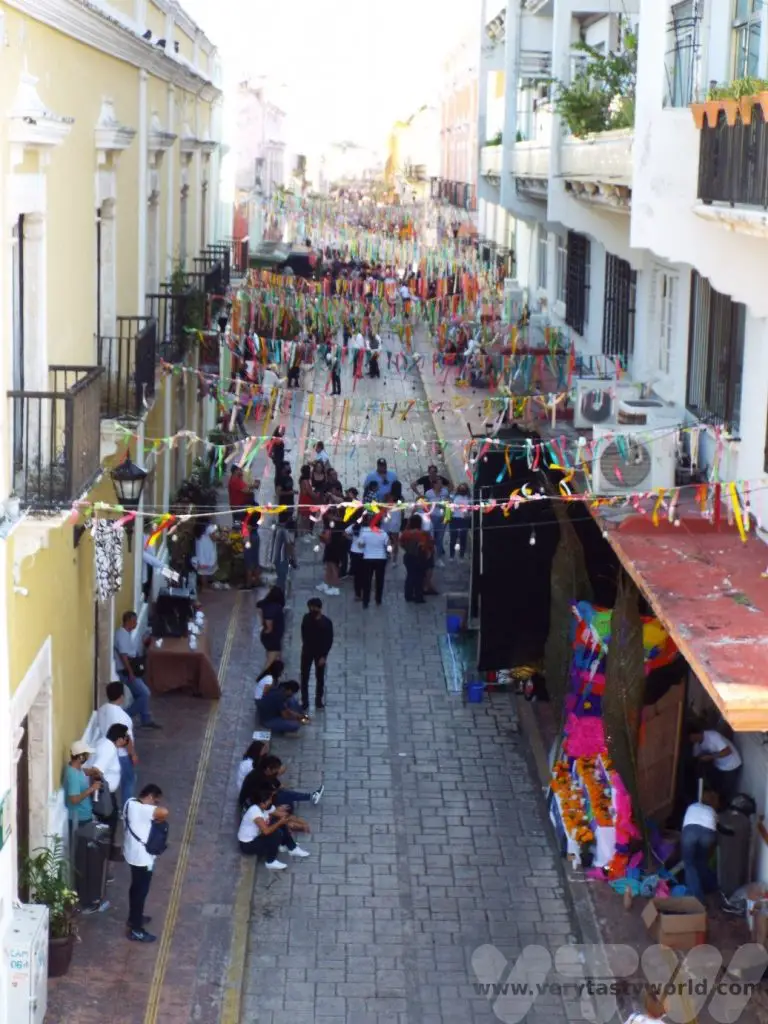
The city decorations reflected the pirate theme.
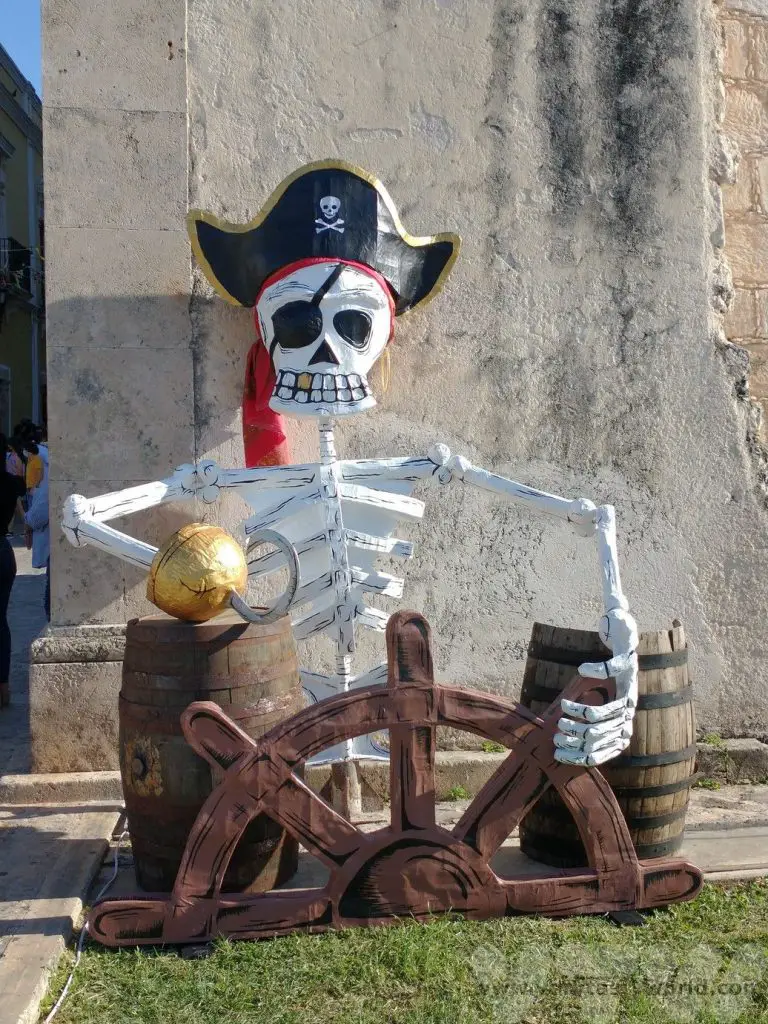
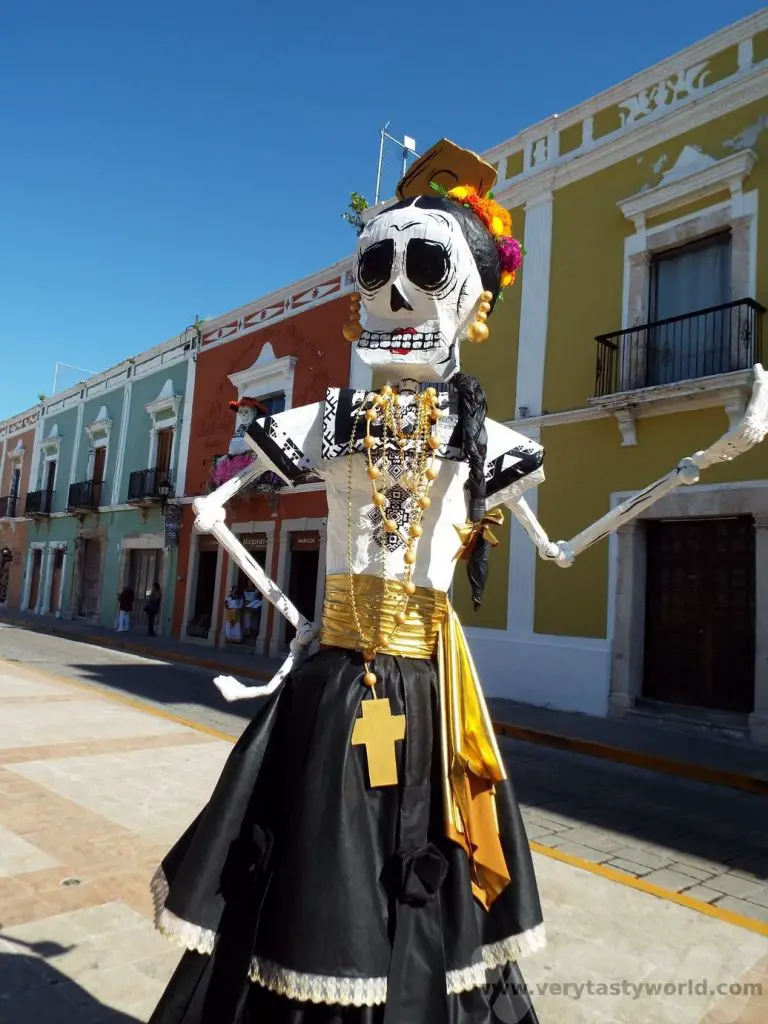
Costumes are an essential part of the celebration. Everyone was happy to pose for photos. It is also possible to get your face painted in full Day of the Dead make-up for a small fee.
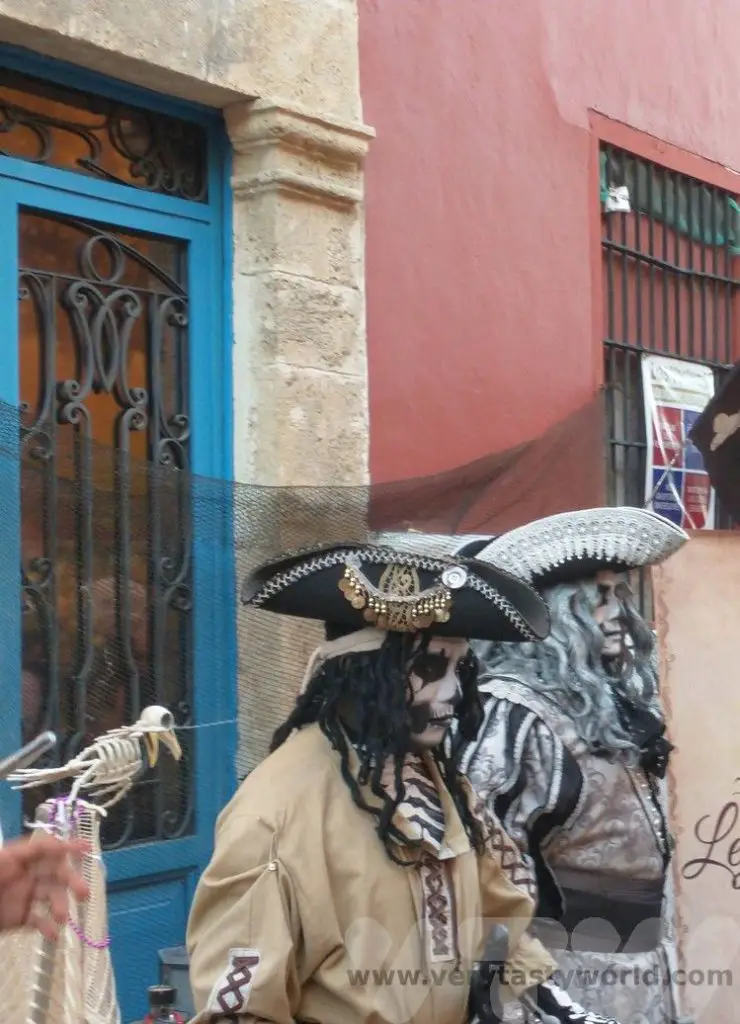
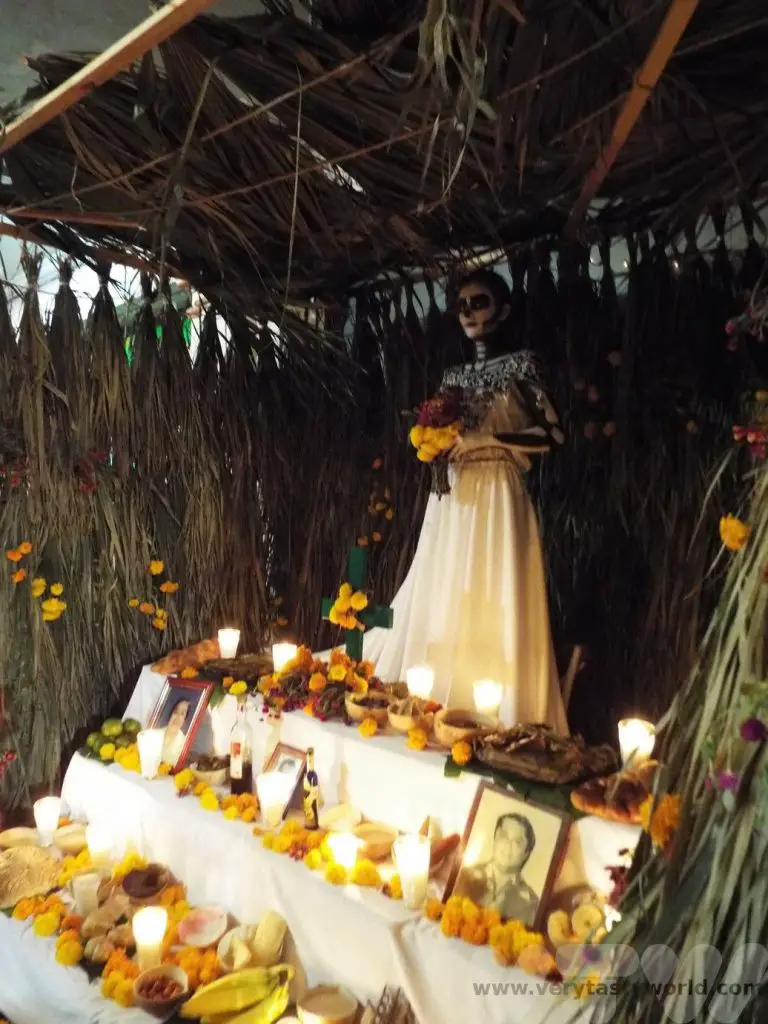
Later in the evening the party started. We enjoyed watching the local children perform a dance with great enthusiasm.
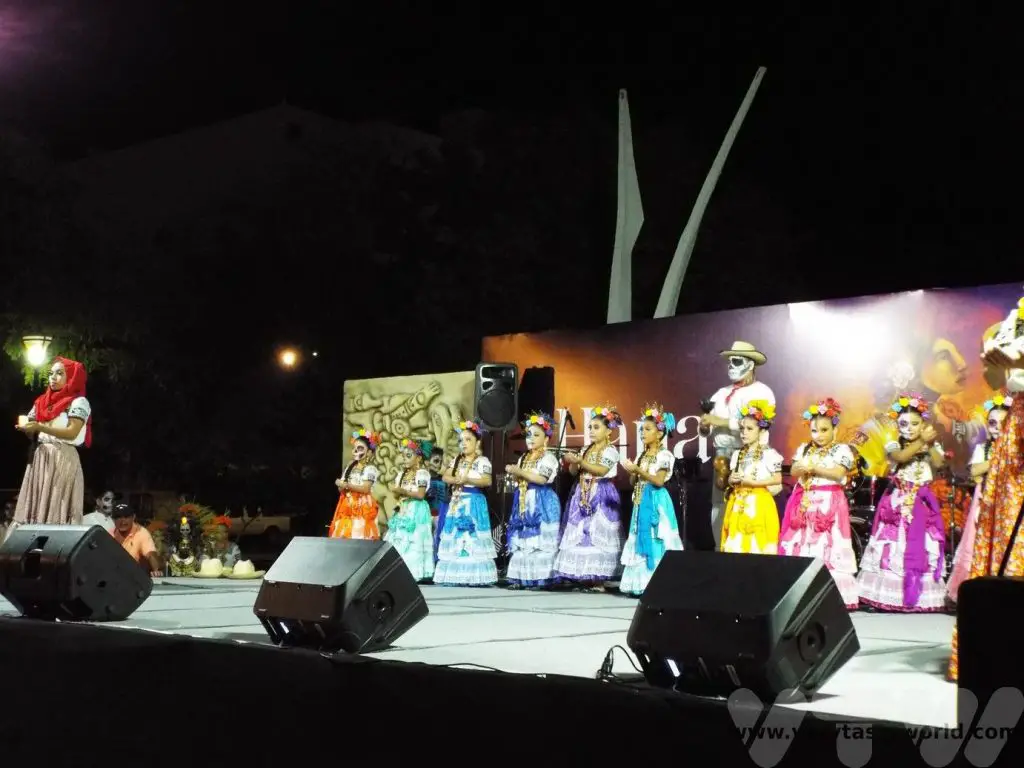
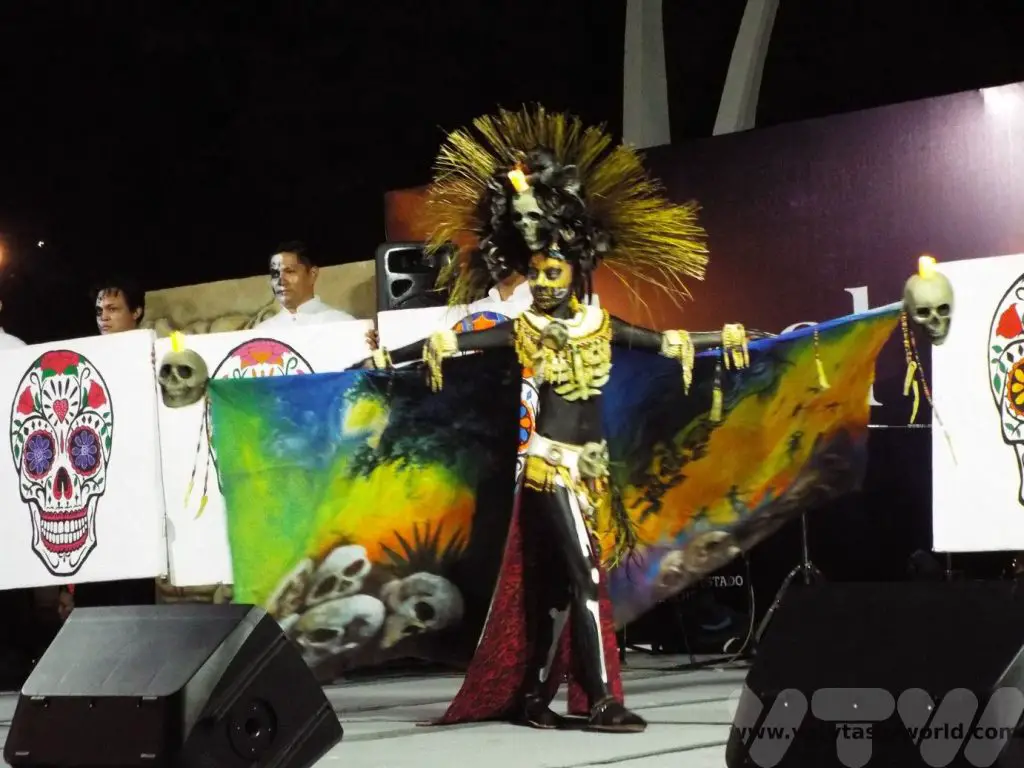
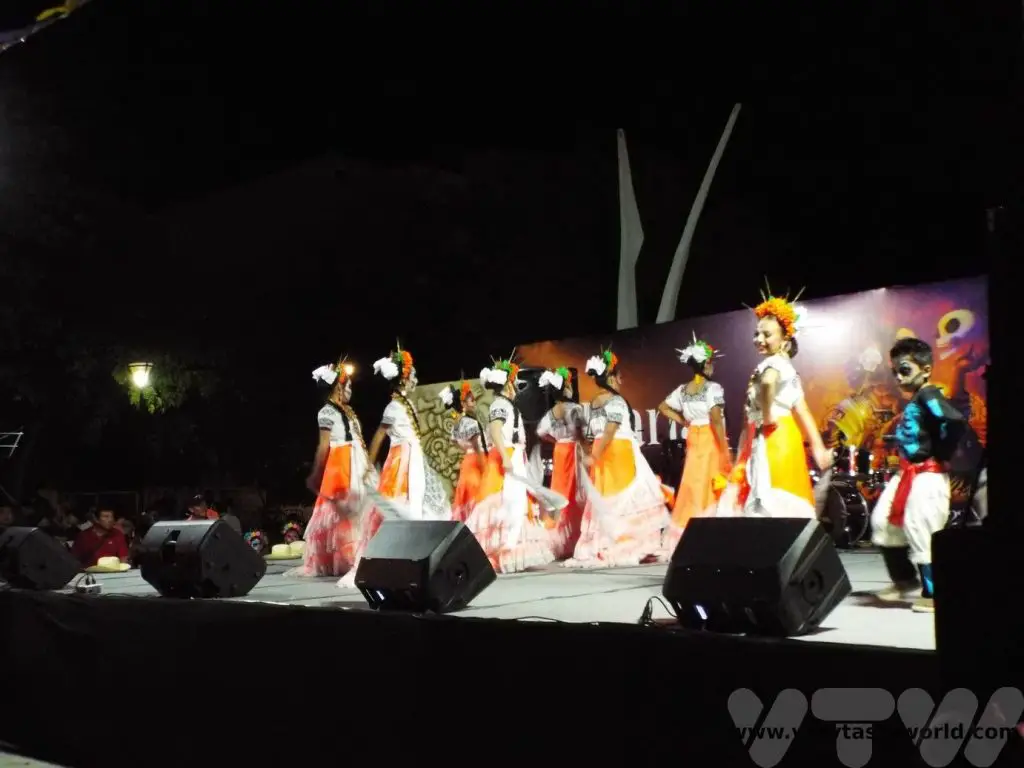
There was dancing…
…and, of course, the parade.
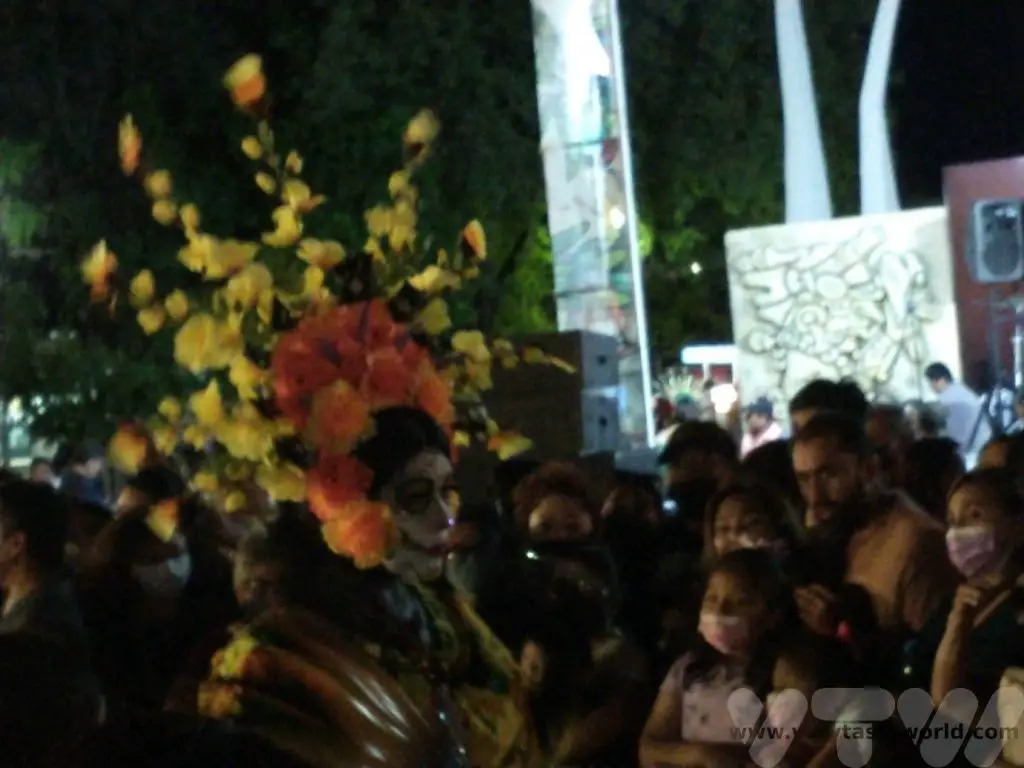
What was lovely about celebrating in Campeche was that it was a much smaller festival – it felt more intimate because it didn’t have large crowds. Above all else, it was such a happy occasion. Everyone was welcome and joining in the celebration was encouraged. We had lots of conversations with friendly locals, who were very pleased to see us.
Even the dogs took part – this little one had possibly the cutest costume ever!

Traditional Food of the Day of the Dead
Along with the food offered to ancestors at the Ofrenda, there are some dishes that are traditionally eaten during the festival.
The most important Day of the Dead food in Yucatan is mucbipollo. It is made with corn bread and shredded chicken, wrapped in a banana leaf and cooked in an underground pit known as a pib. The Mayan word ‘muk’ from mucbipollo means ‘to bury’.
It has a crispy exterior and is delicious but is quite stodgy and very filling. The best street vendors will have queues of hungry punters waiting in line to enjoy a portion.
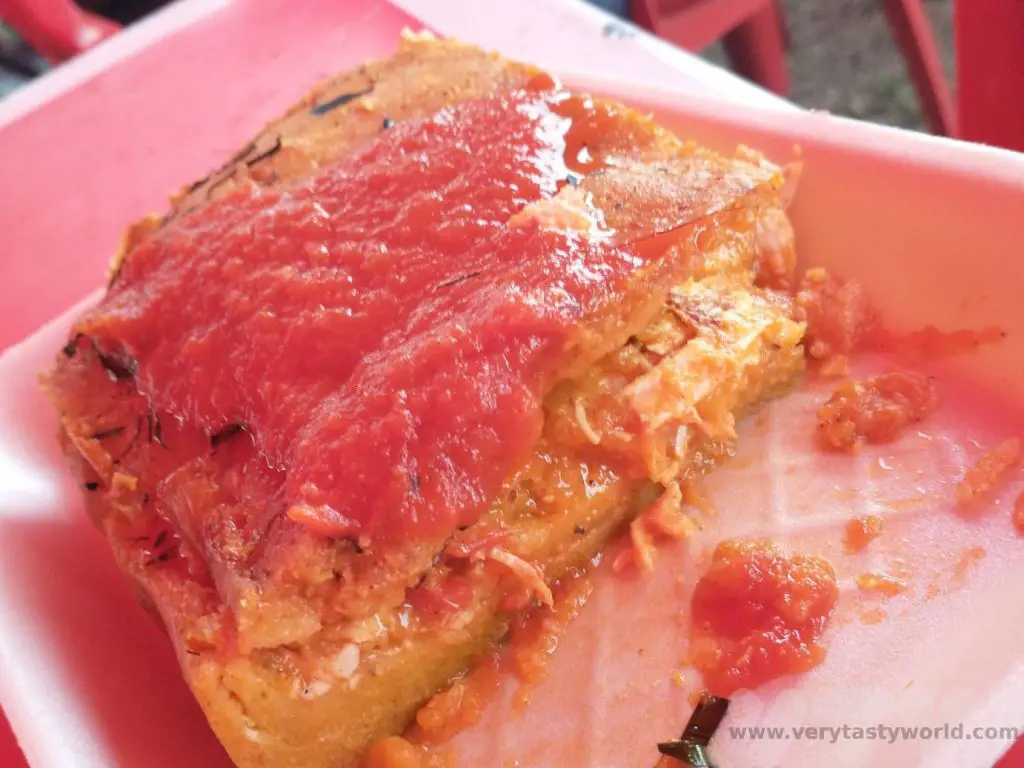
It is a great privilege to be able to join local festivals when travelling. Day of the Dead in Campeche was perfect for us as it was a much smaller, more intimate celebration than in the big cities and we were really welcomed.
And although the Day of the Dead imagery is macabre it is very much a day of joy.
Related Posts You May Enjoy

- Best Time To Visit Machu Picchu 2024 Update
- A 2 Week Patagonia Itinerary
- Day of the Dead in Campeche
- A Galapagos Land Based Itinerary
- RECIPE: How to Make Costa Rica’s Gallo Pinto
- A Tasty Puebla Food Tour
- Costa Rica Wildlife Sanctuary – Caño Negro
- Visit Torres del Paine National Park in Patagonia
- Atacama Desert Itinerary
A Tasty Puebla Food Tour
Puebla is just a couple of hours away from Mexico City and is a complete contrast to that glorious, sprawling metropolis. It is a delightful city to visit and the historic centre is a UNESCO world heritage site. It is also a city of great deliciousness – the Puebla food scene is astonishingly diverse and exciting. After all, this is the city that claims to have invented mole poblano!
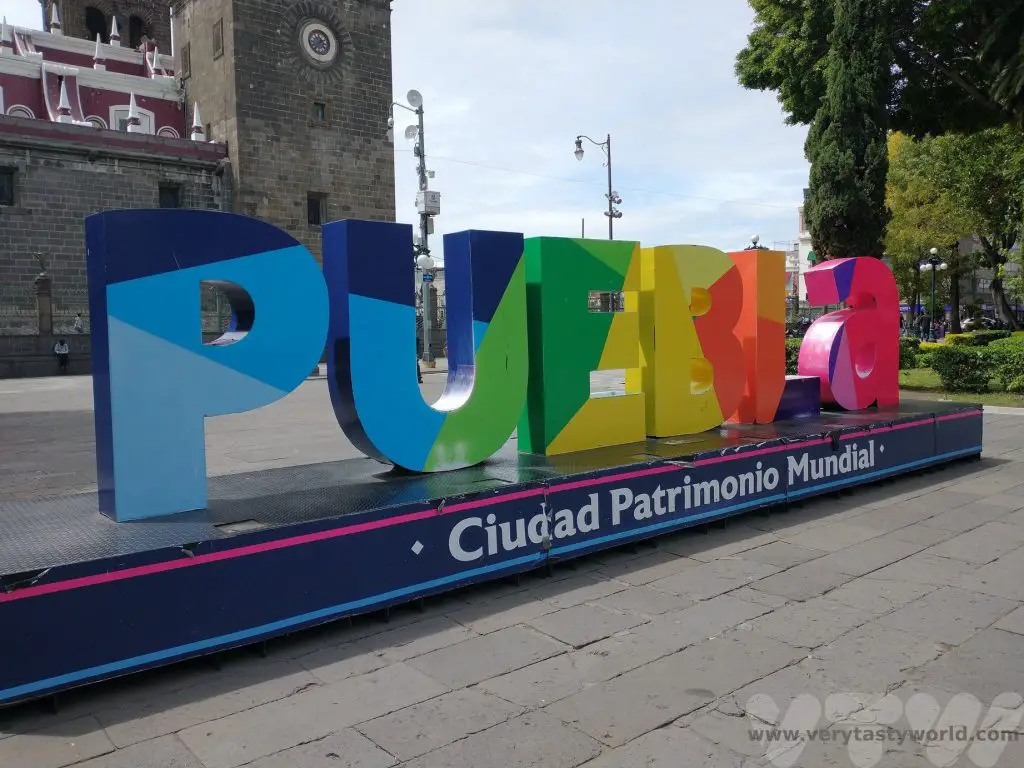
Getting to Puebla
We were travelling through Mexico on buses, which was a lovely way to see the countryside. The buses are largely comfortable and on time but journey times can be long. The bus stations are usually located on the edge of town, so we tended to use taxis to get to and from our hotels. Most of the taxi drivers were excellent and, even though the journeys were unmetered, the costs were pretty cheap – usually lower than $10. There was only one place where we got shafted by a taxi driver and that was in Merida (which is a lot more touristy) who overcharged us for a very short journey so it’s advisable to agree on a price in advance – and to be able to count in Spanish! When we arrived in Puebla we discovered a taxi rank where we could pre-pay our fare which made everything much easier.
The journey from Mexico City to Puebla took two hours. If travelling from Oaxaca, the travelling time is around five hours.
We were staying at the Colonial Hotel in Puebla, just a block away from the Zocalo main square. It’s a former Jesuit monastery, dating from the 17th century. We had an enormous room with the highest ceiling we had ever seen. Also, they provided a ginormous water dispenser in the room (you can’t drink the tap water in Mexico) and this was very useful.
Places to Visit in Puebla
On arrival we went straight to the zocalo, which is a lovely space filled with trees, sculptures and benches. We always find it useful to head for the tourist information office when we arrive at a new city, and Puebla’s is located on the northeast corner of this square, on the side opposite the cathedral. It was great chatting with the friendly staff who offered us a map of the area and list of attractions to visit, as well as some foodie recommendations.
Puebla was founded by the Spanish who had set up a trade route between Veracruz on the coast and Mexico City. The area was originally forested and hadn’t been populated by indigenous peoples, it was located between the settlements of Tlaxcala and Cholula. The soil is volcanic and as a result, the land is fertile and ideal for growing crops. The Spanish brought crops such as wheat with them and the food is therefore a fusion of local ingredients with European.
Puebla is a city filled with churches. It feels as though there is one on every street. It’s perfectly okay to wander inside although it’s advisable not to look around if a service is ongoing. There are two churches that are absolute must-sees.
Puebla Cathedral
Located on the south side of the zocalo, the Basilica Cathedral of Puebla, also known as the Cathedral of Our Lady of the Immaculate Conception, was one of the first cathedrals to be built in Mexico. It was consecrated in 1649. It is a huge cathedral.
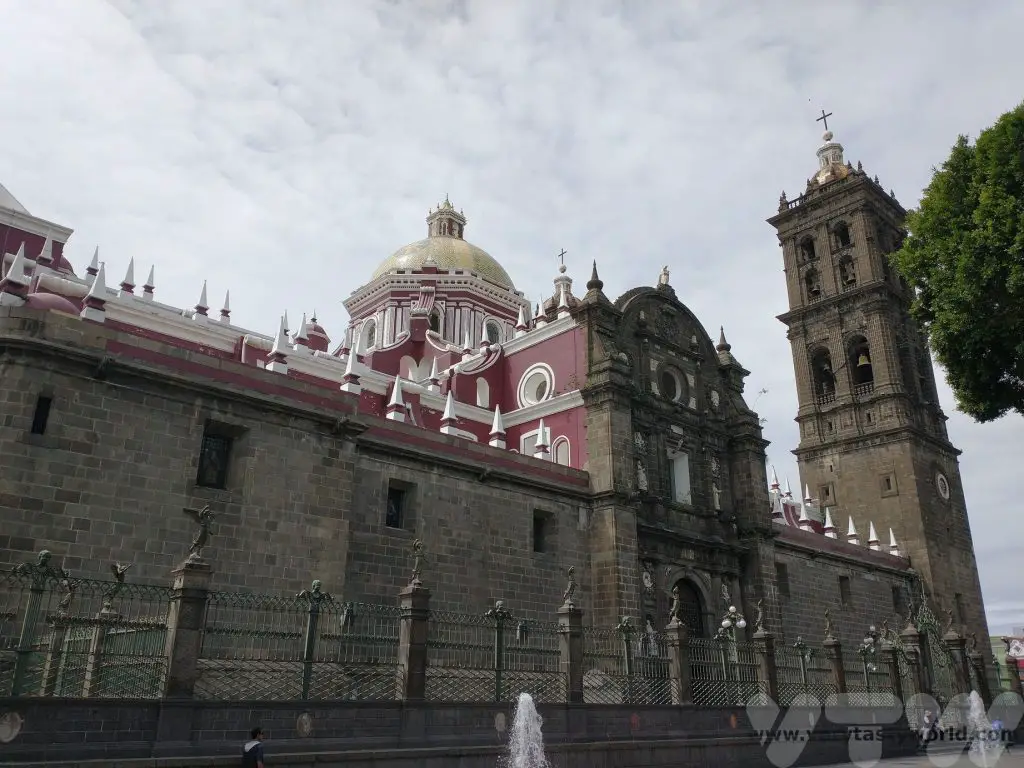
Like many large churches in Mexico, it has multiple domes and altars. The high altar is particularly ornate.
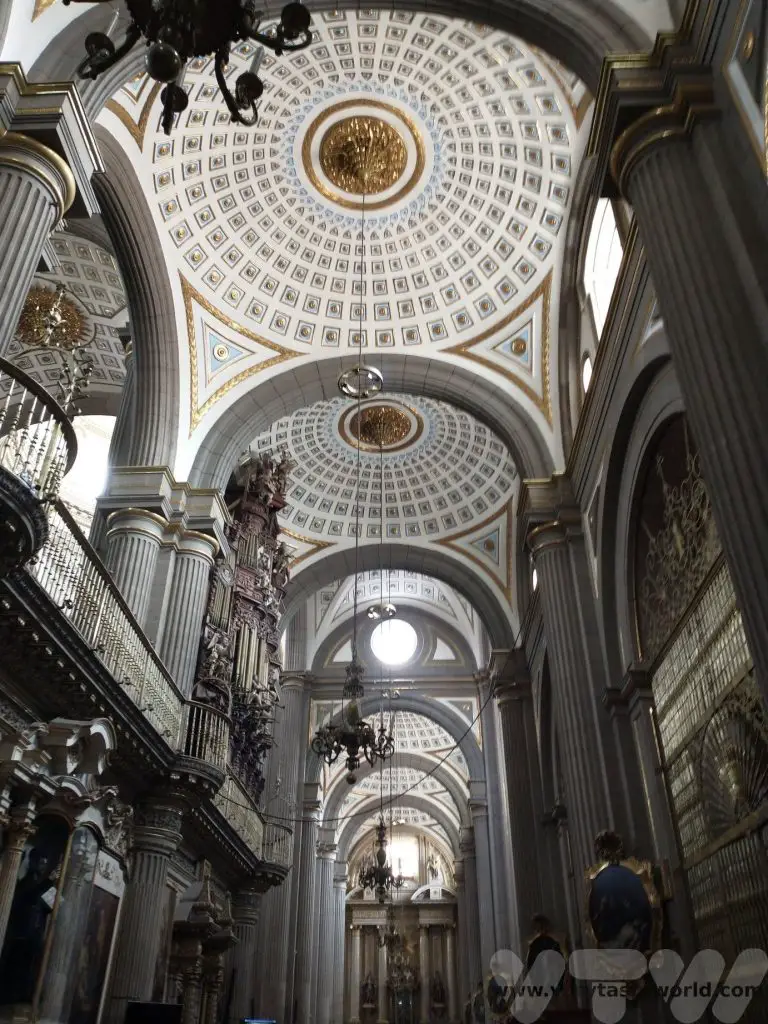
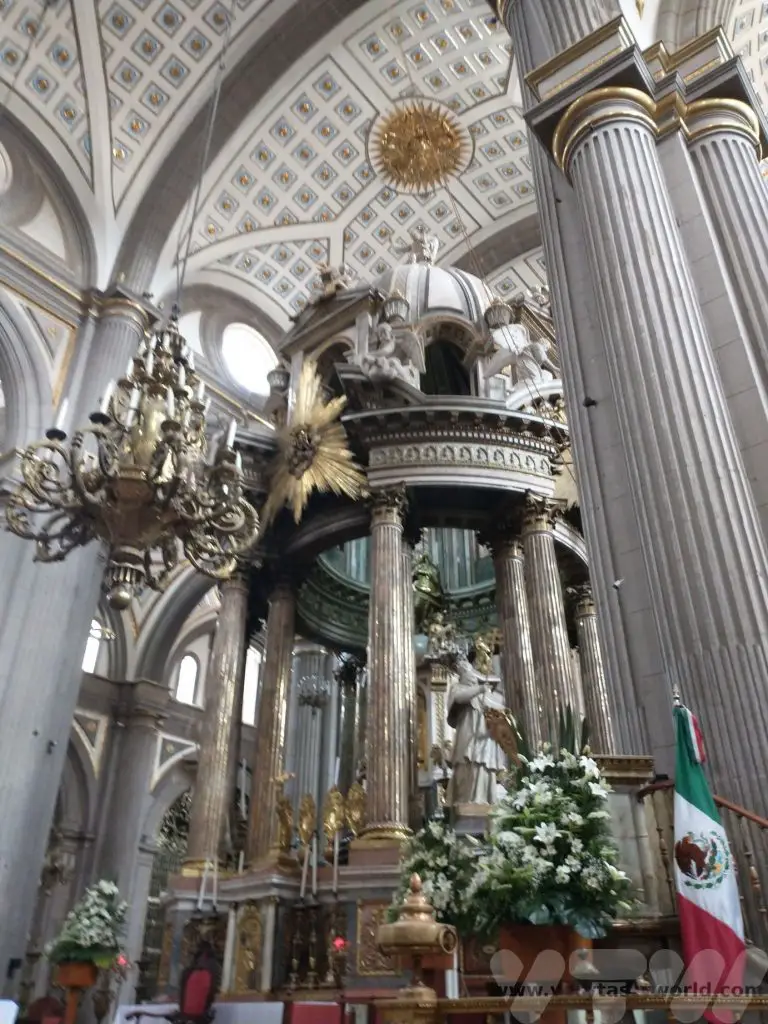
Church of Santo Domingo
The Church of Santo Domingo is remarkable for its chapel dedicated to Our Lady of the Rosary. It is a classic example of new Spanish baroque architecture and in its time was considered to be the 8th wonder of the world. It was conceived in 1650 and completed in 1690.
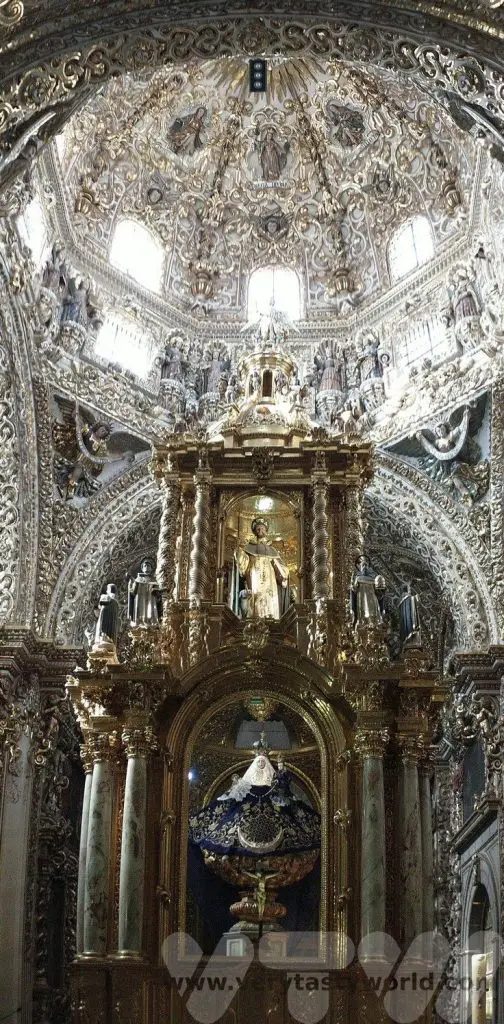
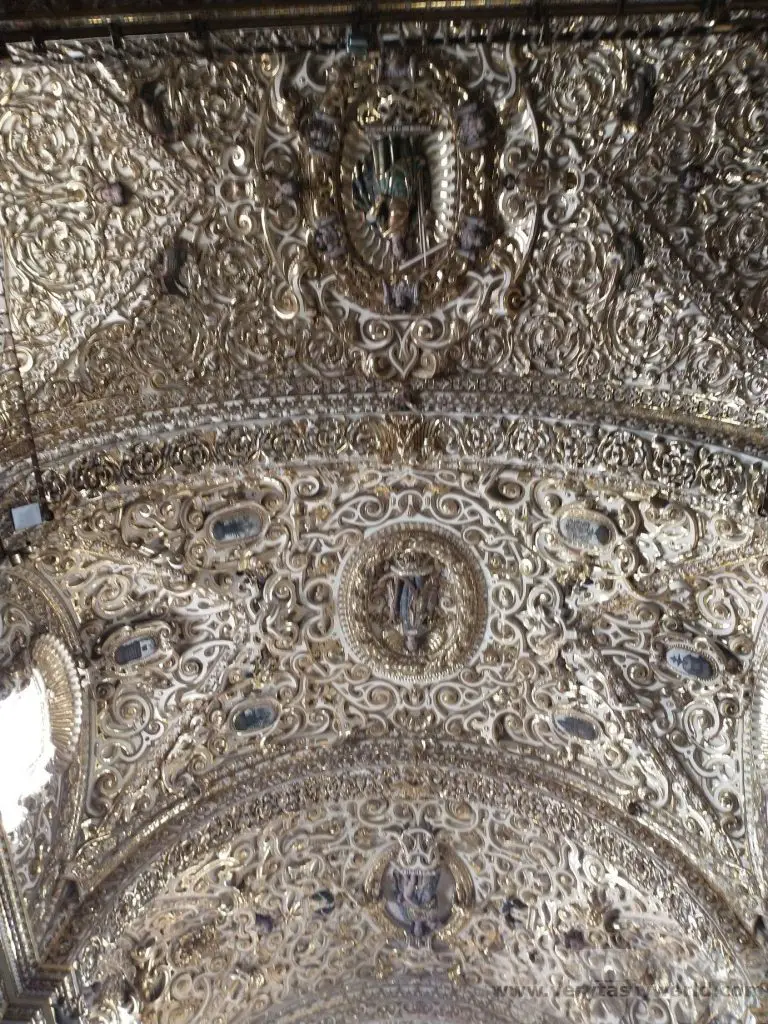
The chapel is decorated with gilded plasterwork, the highly decorative and intricate designs are coated in 24-carat gold leaf.
Biblioteca Palafoxiana
The Biblioteca Palafoxiana is the first and oldest library in the Americas and is another UNESCO site. Chock full of some 45,000 books dating from the 15th century onwards and categorised according to the subject, you can wander through the library and view the shelves as well as some books on display in glass cabinets. It has a wonderful smell – just breathe in deeply to inhale the scent of centuries-old literature!
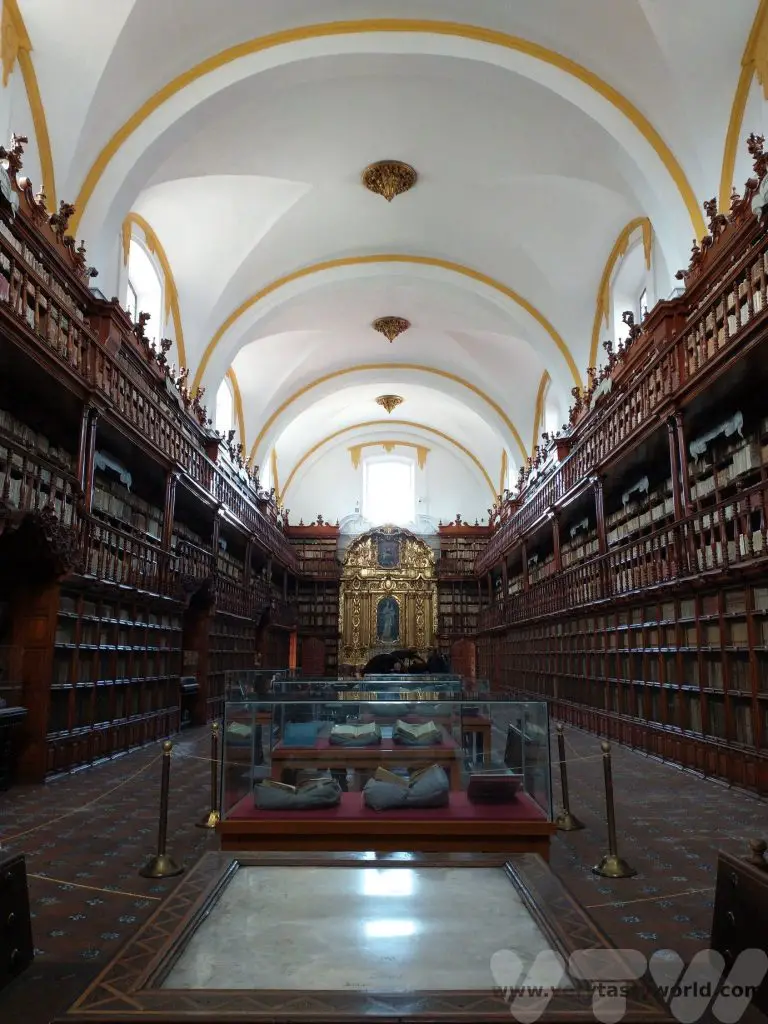
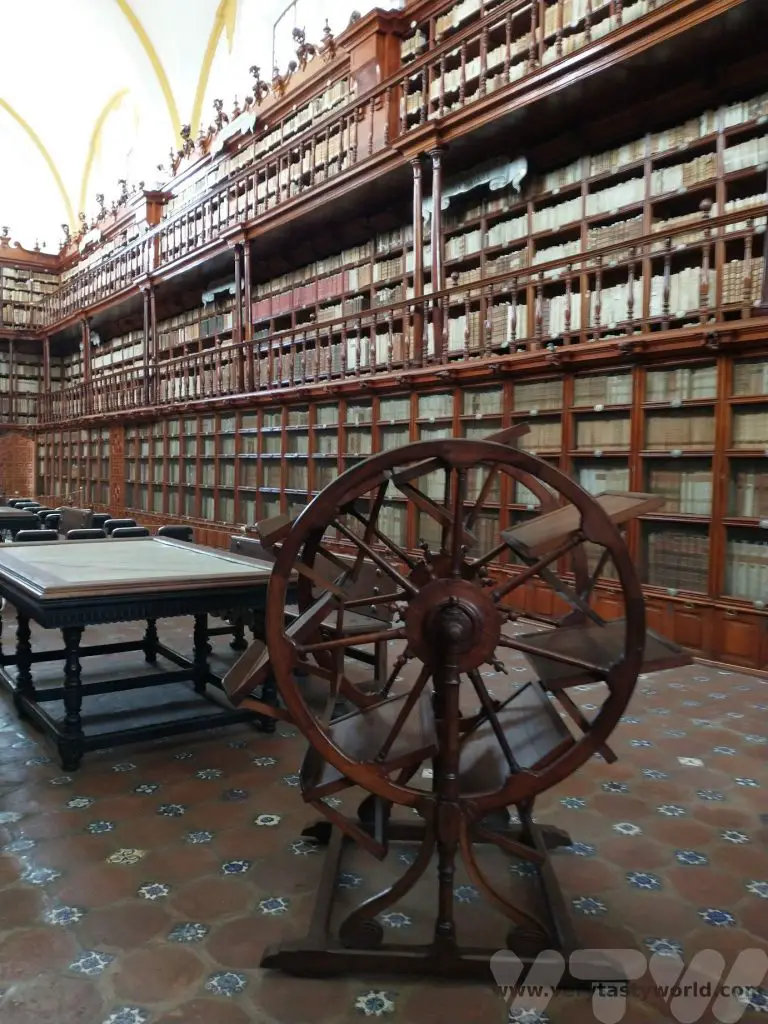
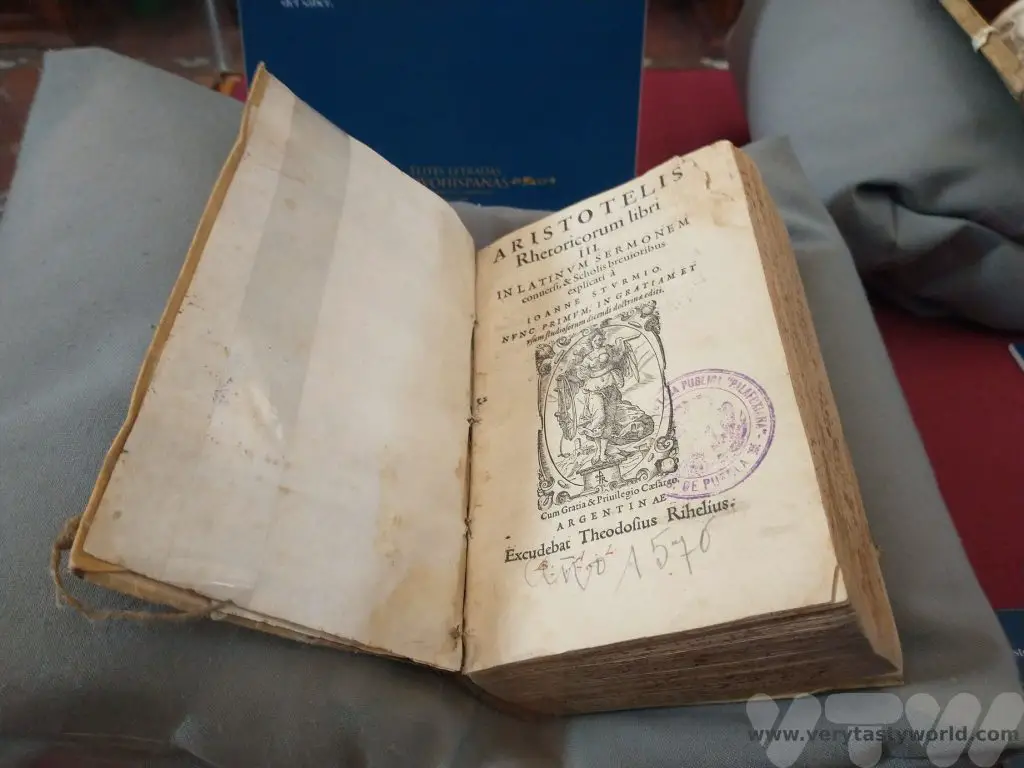
Museo Amparo
This free museum and art gallery is a joy to visit and highly recommended. Set in two colonial-era buildings across multiple levels it has several permanent and temporary exhibitions.
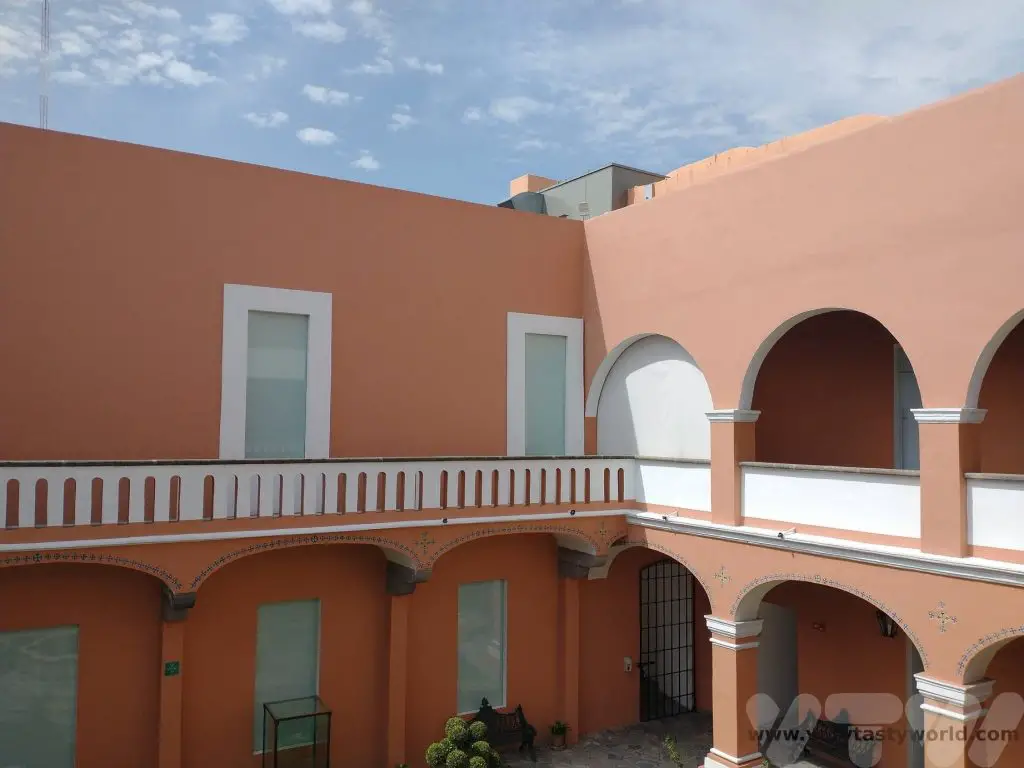
The ground floor is dedicated to the pre-Hispanic history of the region and sets it in the context of world history. It has a huge number of fascinating artefacts with pieces dating from as early as 2500 BCE.
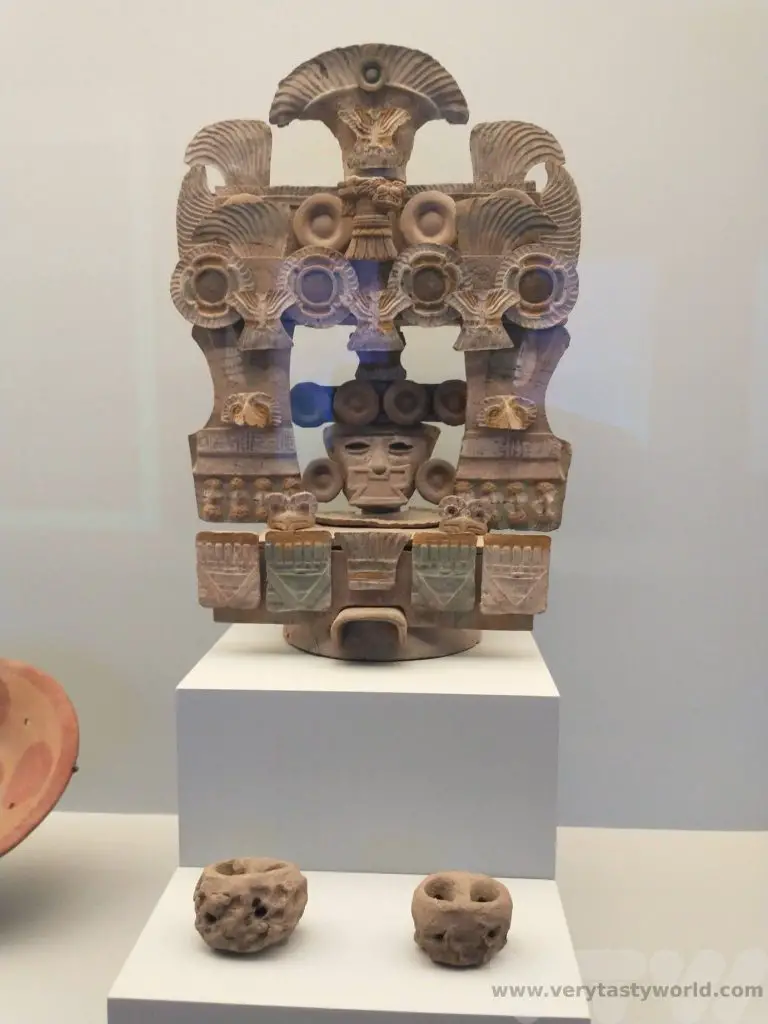
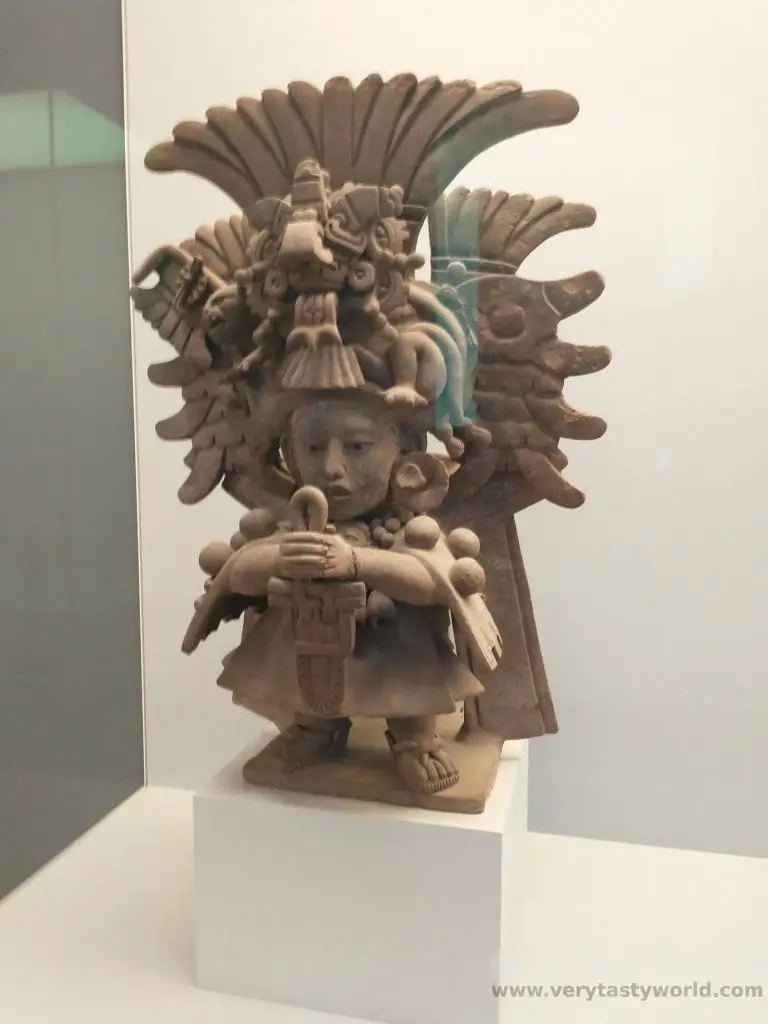
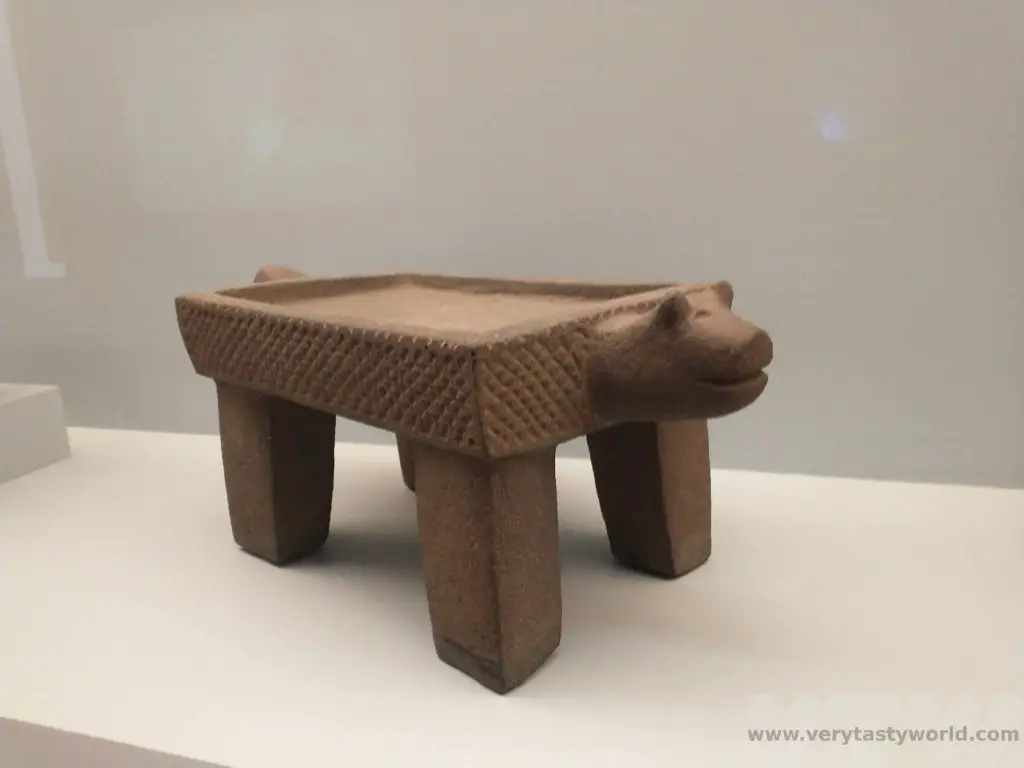
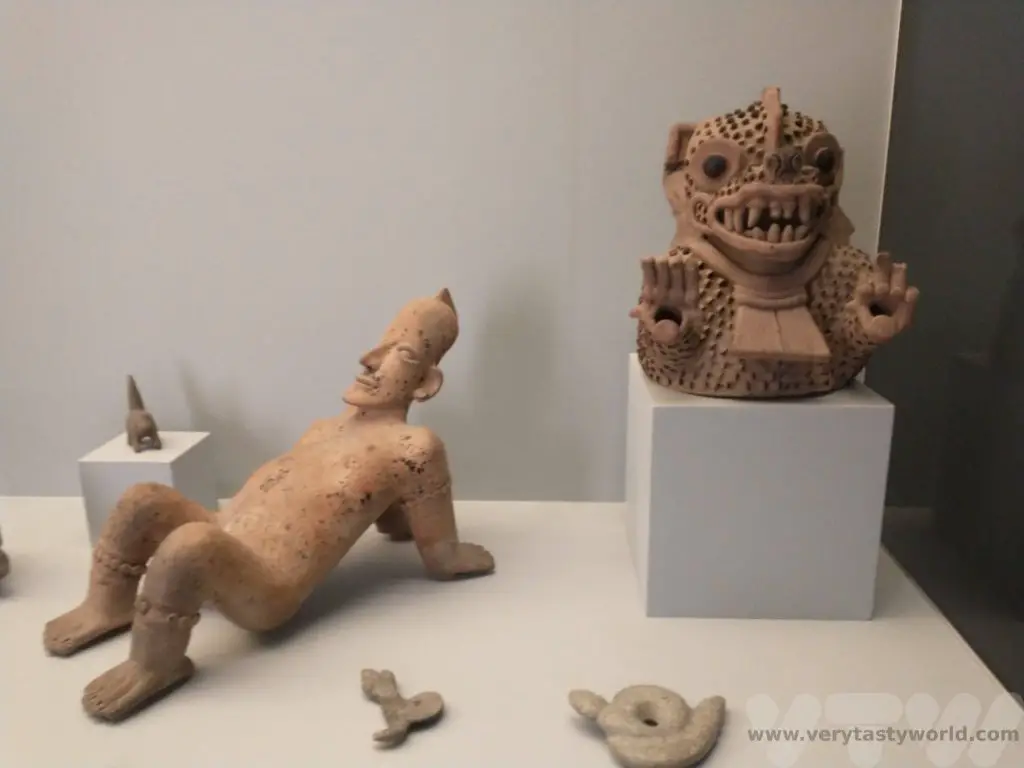
The building was the home of the Espinoza from 1871 to the 1980s, and this is reflected in the upstairs exhibits which are set out as rooms showing objects from the colonial period, including drawing rooms and a kitchen.
The Amparo has a terrific modern art gallery. There are also temporary exhibitions – we were able to enjoy an exhibition on 1970s feminism when we visited. It’s possible to spend several hours here so definitely set some time aside to explore this wonderful place.
Don’t do what we did and forget to go to the cafeteria on the second floor. Even if you don’t want a coffee or tea, there’s apparently a fabulous view of the city. We only learned about this after our visit. We’ll have to return.
Museo de la Revolución- Museum of the Mexican Revolution
This house in Calle Santa Clara was the home of the Serdán family and was the location of the first conflict of the Mexican Revolution which took place in 1910. President Porfirio Díaz had been in power for decades and was becoming increasingly unpopular. Aquiles Serdán was a supporter of revolutionary leader Francisco Madero and started planning an insurgence against the president.
However, the rebellion was foiled when members of Díaz’s government learned of their plans, and Aquiles, Máximo, Carmen, and Natalia Serdán, along with others, defended themselves inside the house from hundreds of soldiers who were shooting at them. Aquiles survived the gunfight and hid inside a hole under the floorboards where the revolutionaries had stockpiled their weapons. Unfortunately, he coughed when the authorities raided the house, so was discovered and later killed.
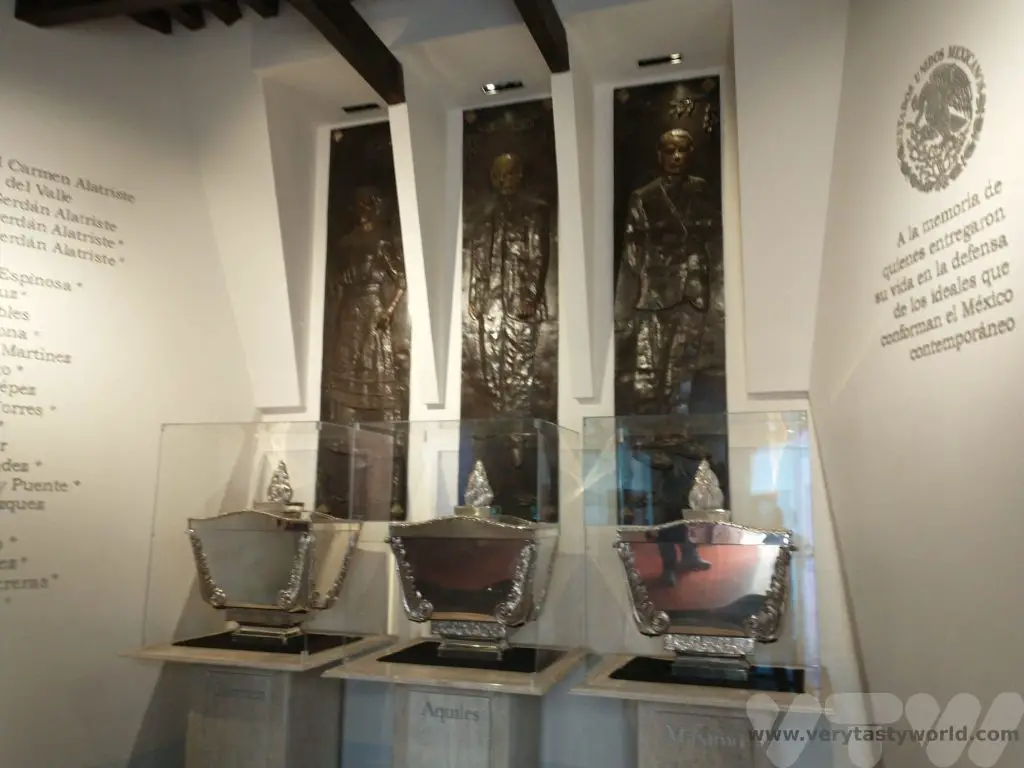
The house has been converted into a museum. It displays the living arrangements of the families.
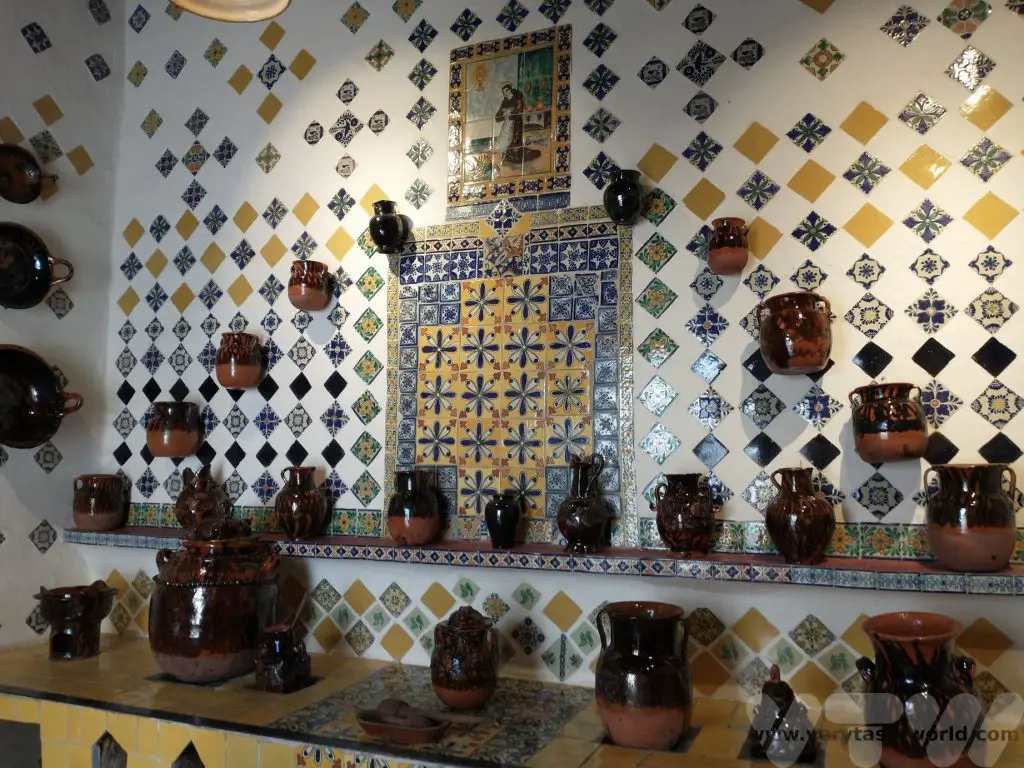
It also gives lots of information about the background of the revolution and its outcome. There is also a room dedicated to the women of the family.
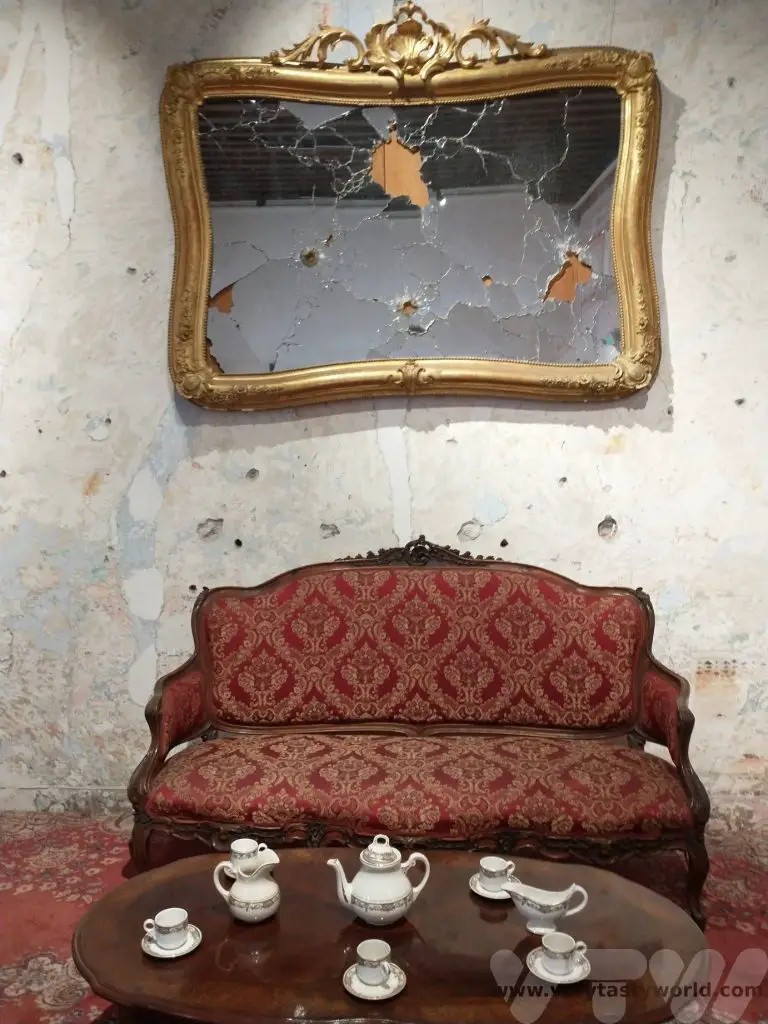
While the bullet holes on the exterior of the house look dramatic, they are actually fake. The building was renovated a few years ago and the workmen unwittingly rendered over the plaster, covering the original holes! After this mistake had been discovered the ‘bullet’ holes were drilled back in. If you look closely it’s quite clear that they could never have been made by bullets fired from guns manufactured in 1910.
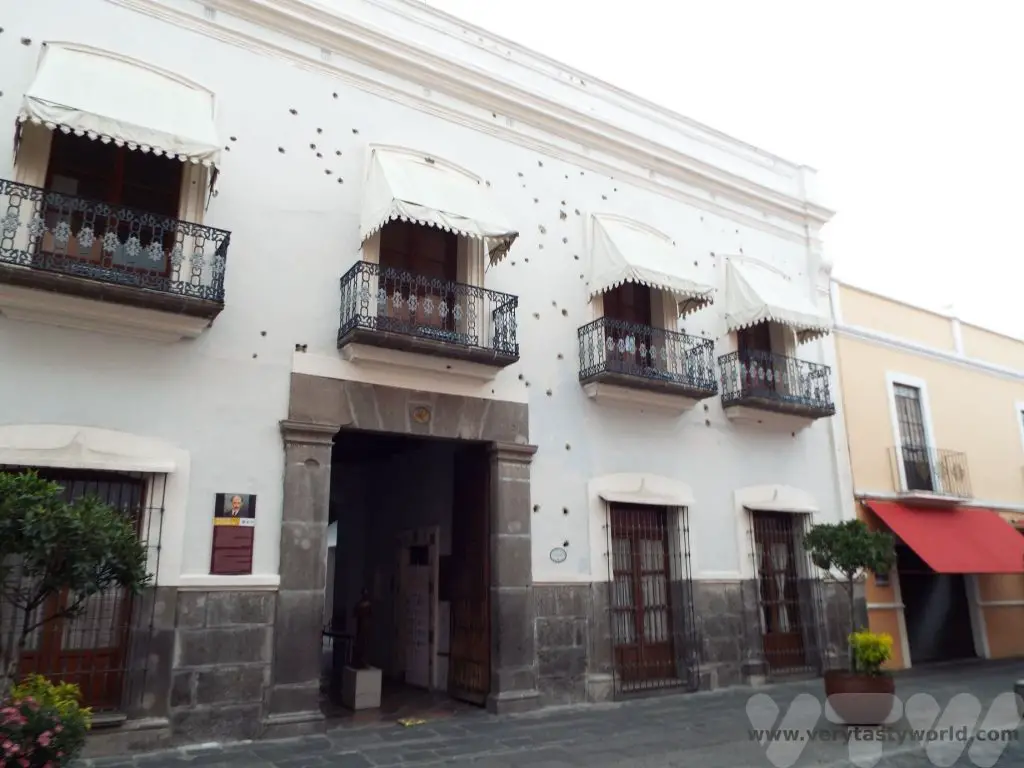
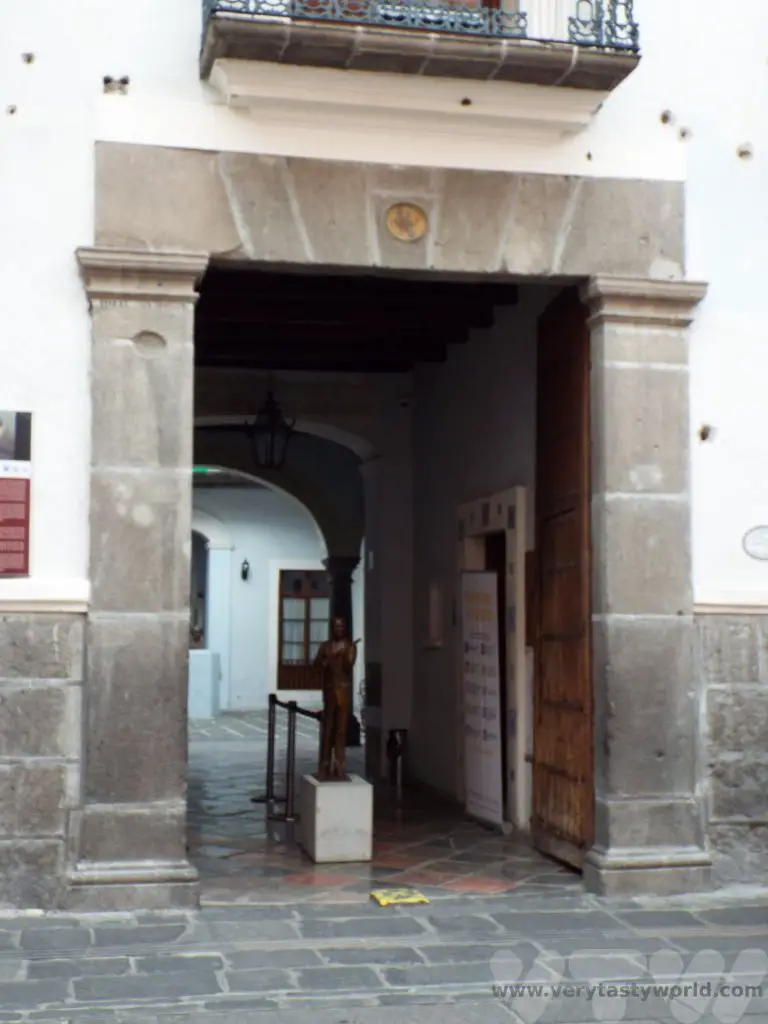
There are some genuine bullet holes in the stone doorframe at the museum’s entrance.
Other Attractions
There are lots of other places to see in Puebla. These are some of the highlights:
Señor de las Maravillas is a 17th century carving located in the Temple of Santa Monica. It is said that the image of Christ was carved from a tree that had been struck by lightning.
Municipal City Hall, located on the north side of the zocalo, houses a museum and art gallery.
International Museum of the Baroque is housed in a very cool building designed by Toyo Ito and exhibits a large collection of baroque art.
Lucha Libre – if you like Mexican wrestling (and who doesn’t?) there is a lucha libre arena which runs fun filled events, where masked wrestlers battle it out in the ring every Monday.
Barrio las Artistas is a great place to hang out and view local artists at work. There are bars and restaurants in the area and there is often live music in the evenings.
A Puebla Food Tour
We had organised a foodie tour which was perfect as an introduction to the sheer unadulterated joy that is Mexican, and specifically Puebla, cuisine. We spent an afternoon wandering through the streets stuffing our faces with the most amazing food.
Street Food
In the little alley Pasaje Zaragoza, just off the northern end of the zocalo, is a street food stall which always has customers queueing for its delights – Tacos El Pasaje. This is a family business and, while this type of outdoor street food is not strictly legal, this stall has been around for such a long time it is looked over. There is even a sign above the stall. All the products are made in the morning and stored in a covered basket. The food remains warm most of the day.
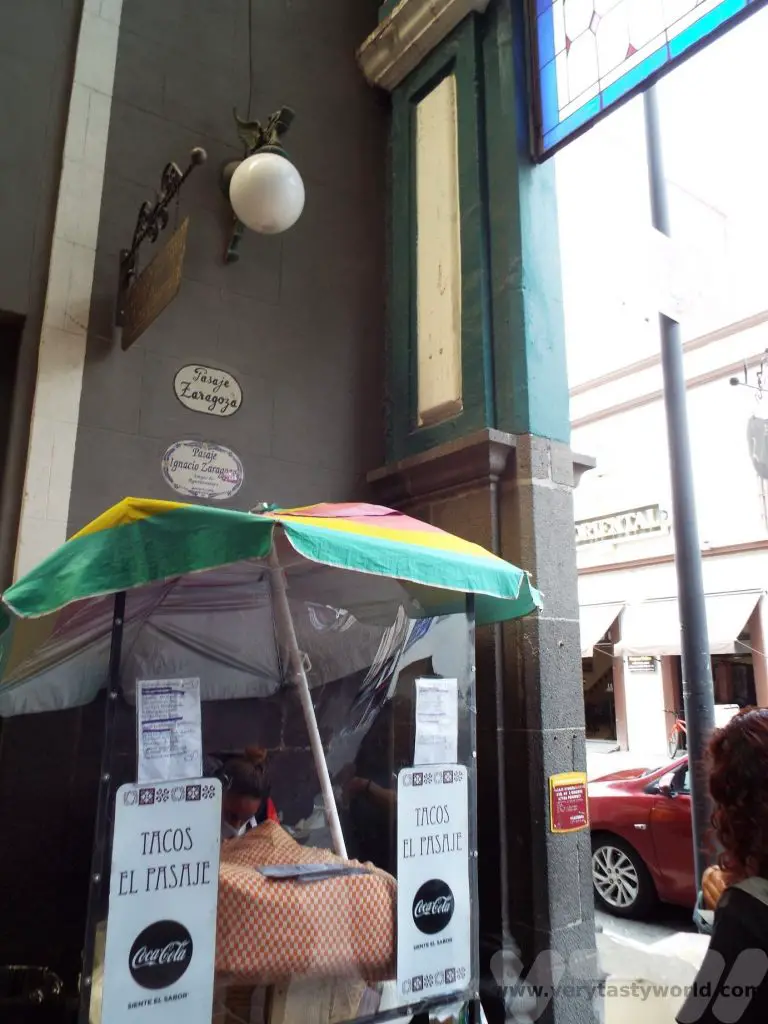
The menu is handwritten – when a particular filling sells out, a line is struck through the menu and you miss out. Until tomorrow, of course. This was where we enjoyed a taco with deep-fried chipotle chilli stuffed with cheese and accompanied with creamy avocado. It was unctuous and not too spicy as the cheese calms the heat of the chilli pepper.
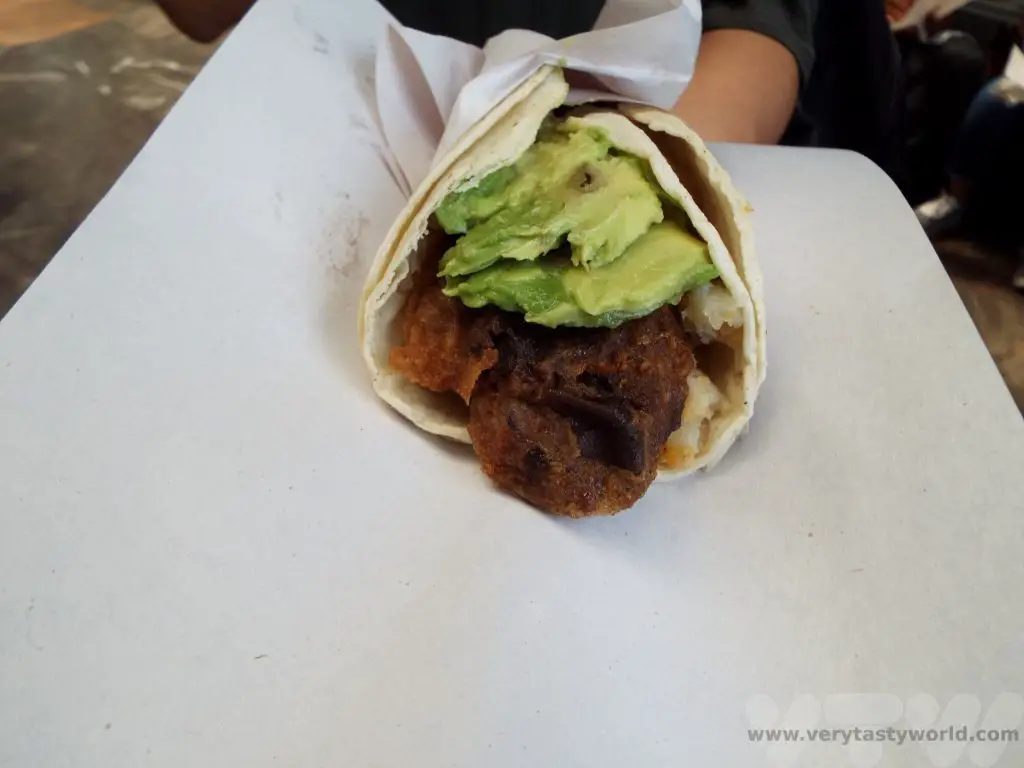
Our next stop was another family business, La Poblanita, a street stall located on Av5 Pte, just around the corner from the Zocalo.
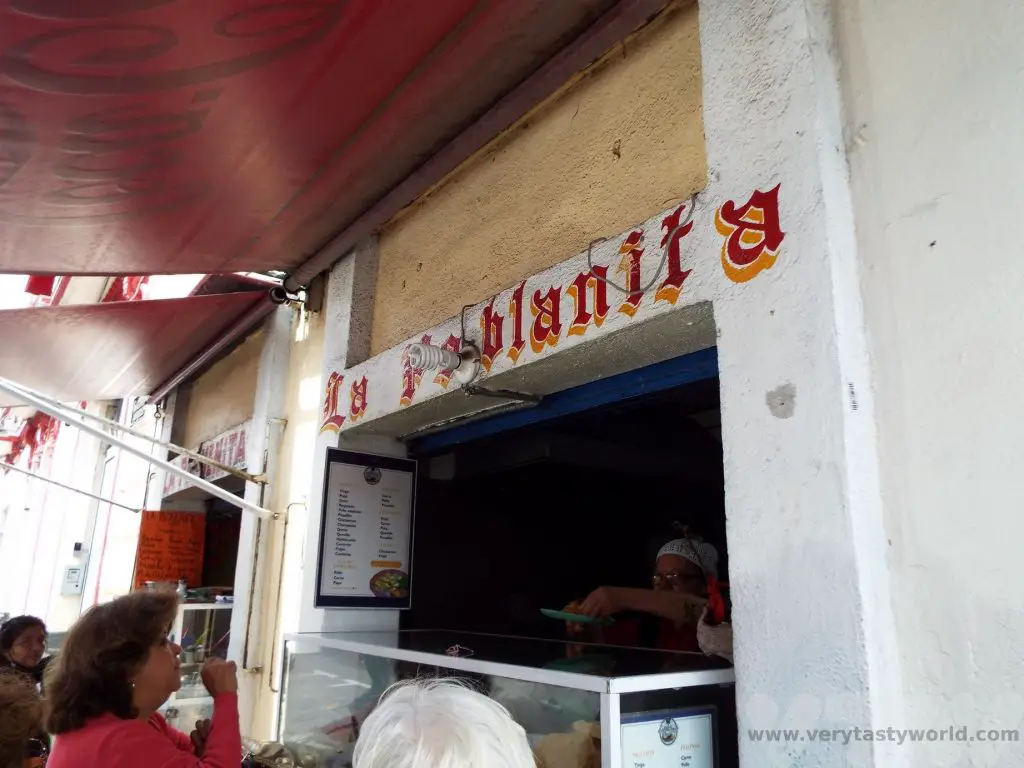
This was where we discovered molotes – a filled tortilla made from corn masa and deep fried. The filling was huitlachoche – corn mushroom – a fungus that grows on the kernel of maize. We had never come across these before and were blown away – the umami flavour was so intense. Our molotes were served with sour cream and salsa.
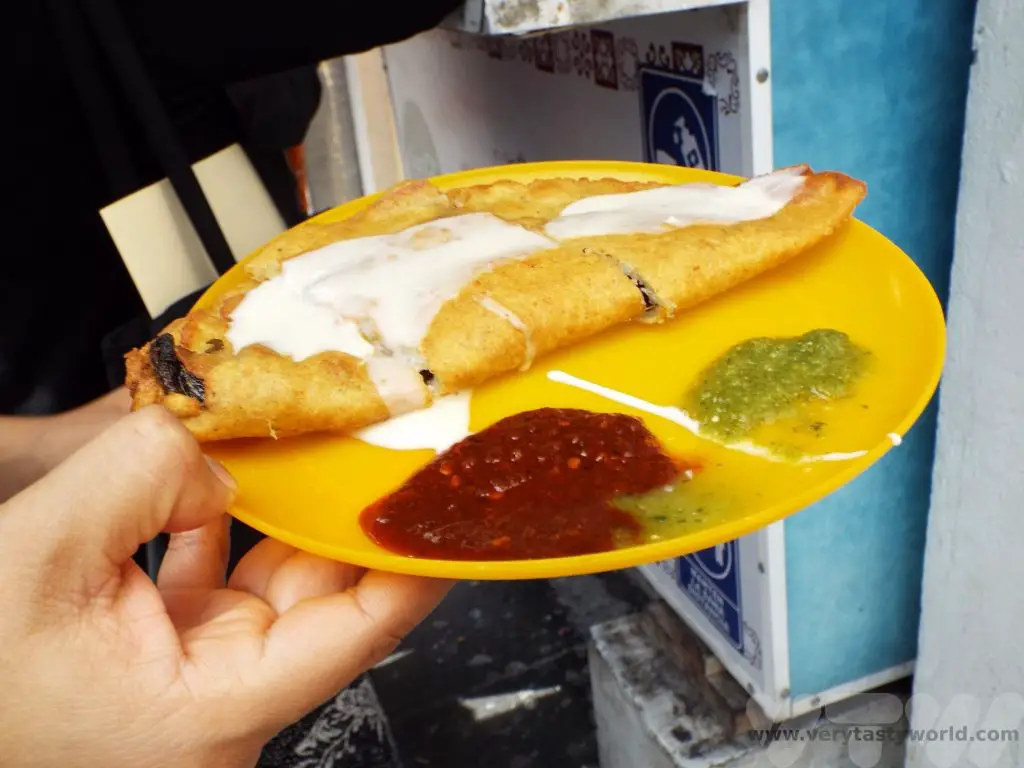
At this stall, we also enjoyed carne (although carne means meat, in this case it was beef) pelonas, wheat bread sandwiches filled with delicious beef and refried beans, and served with with two bright and colourful salsas.
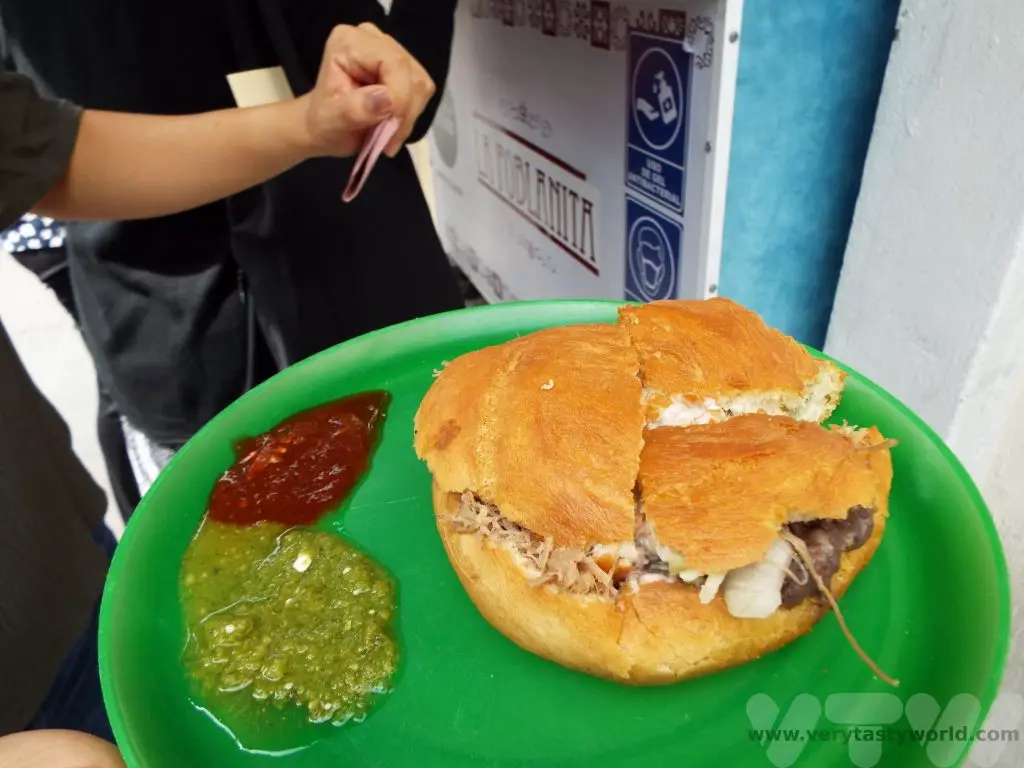
History of Tacos
Tacos could well be considered to be quintessential Mexican food. What we didn’t know was that they are actually a fusion food, imported from the Lebanese community who emigrated to Mexico in the late 19th century. We were quite surprised to see kebab shop-style spits slowly revolving in shop fronts cooking luscious cuts of meat. Tacos became really popular but they evolved in order to adapt to Mexican tastes. Pork, a meat rarely seen in the Middle East, replaced lamb and then the dish incorporated the local inclination to embellish the tacos with all sorts of salsas, condiments, and additional flavours. In Mexico, more is definitely more.
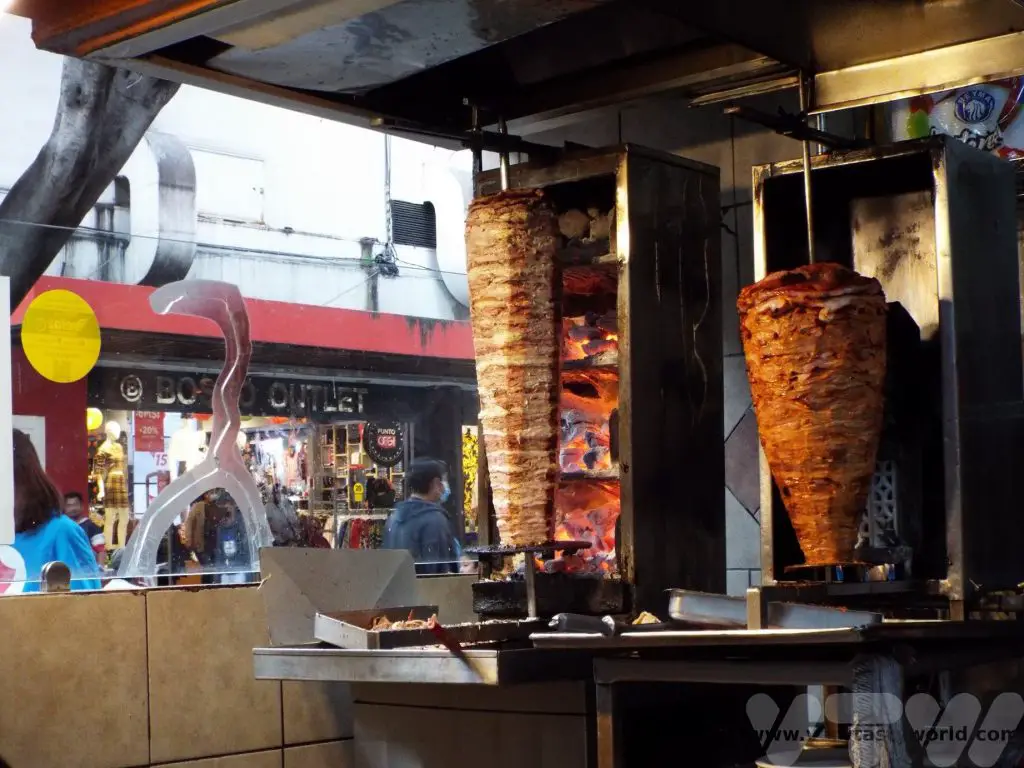
Taco Arabe are chargrilled pork tacos on a wheat bread tortilla. It’s a flatbread, a bit like a pitta but without the pocket – instead it is folded. We ate this with a sweet chipotle sauce and a squeeze of lime.
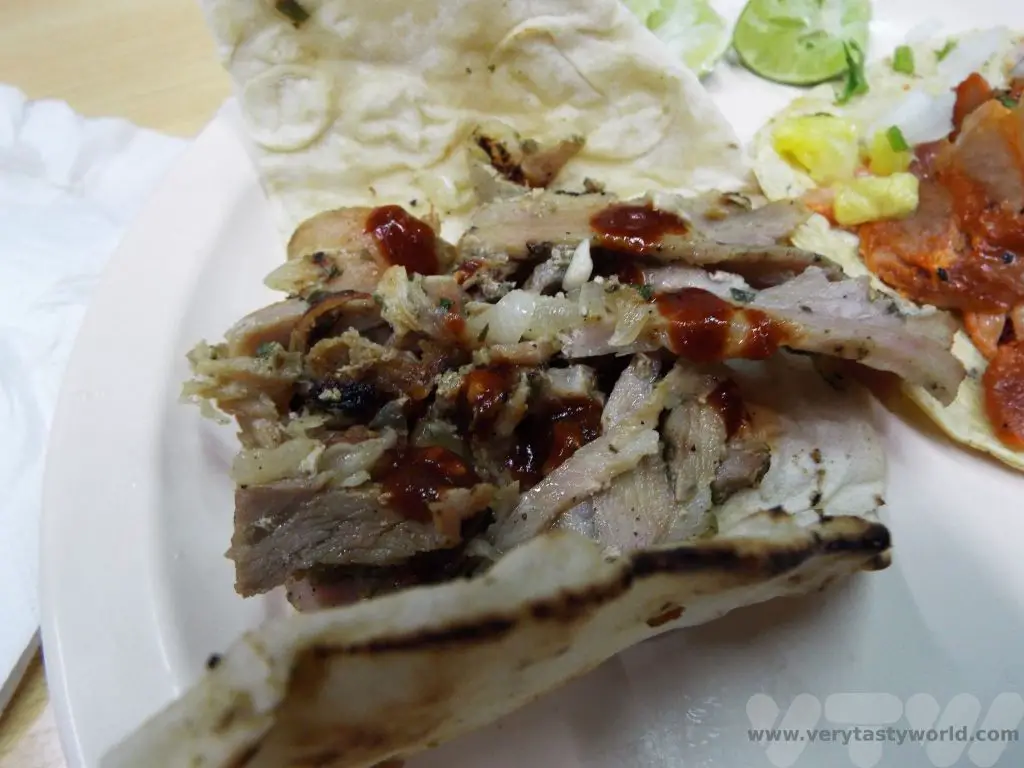
Al Pastor tacos have spiced pork inside a corn tortilla. We ate these with teeny chunks of pineapple, lime juice, coriander, finely diced raw onion, and a creamy avocado sauce.
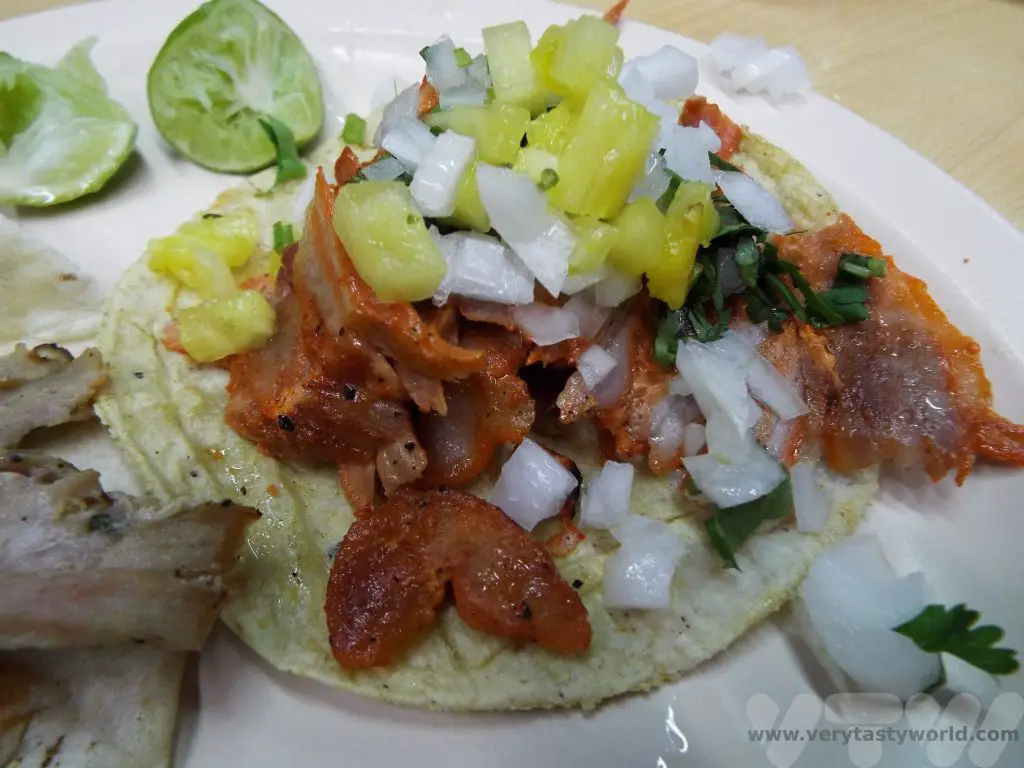
Most of the taco restaurants that we visited offered a number of salsas and multiple wedges of lime for the table. The etiquette for tacos is that they will arrive at your table either folded or open. If they are folded, open them up, add whatever salsa and additional flavours you want, roll or fold them up again, and scoff.
Our next stop offered some sweet surprises. The nuns at the convent on Santa Clara make cakes and sweets and these are sold in the lovely shop across the road.
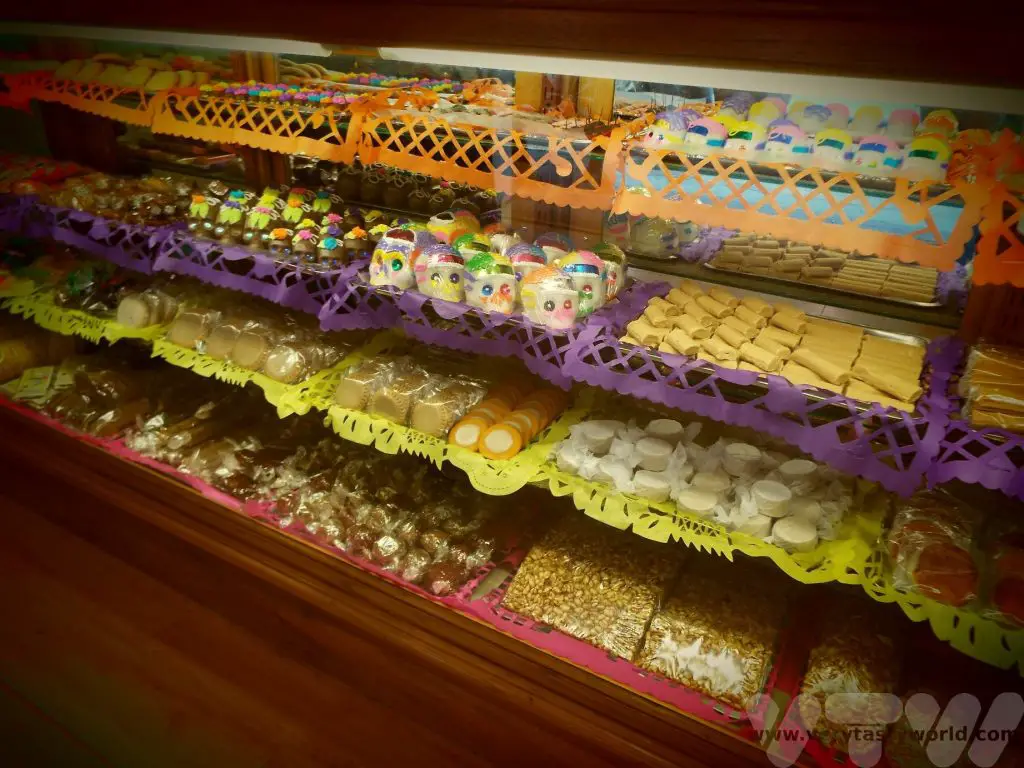
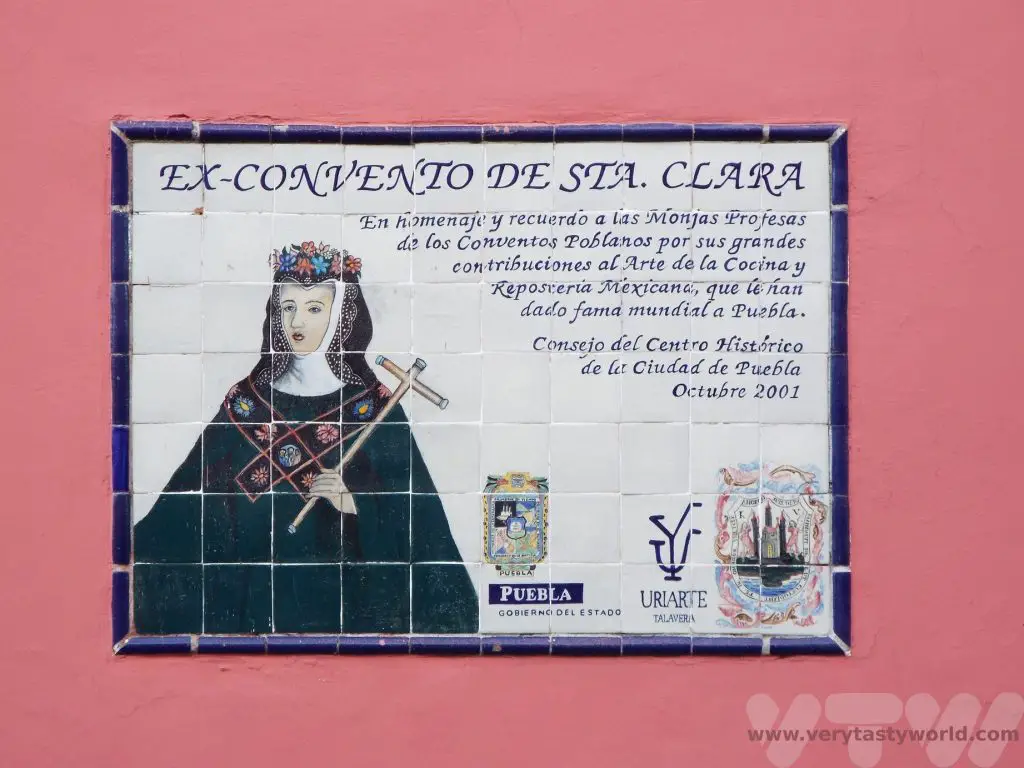
Camotes de Santa Clara are a sweet potato cylindrical-shaped paste flavoured with fruit and honey. There are several fruit flavours available – we chose strawberry.
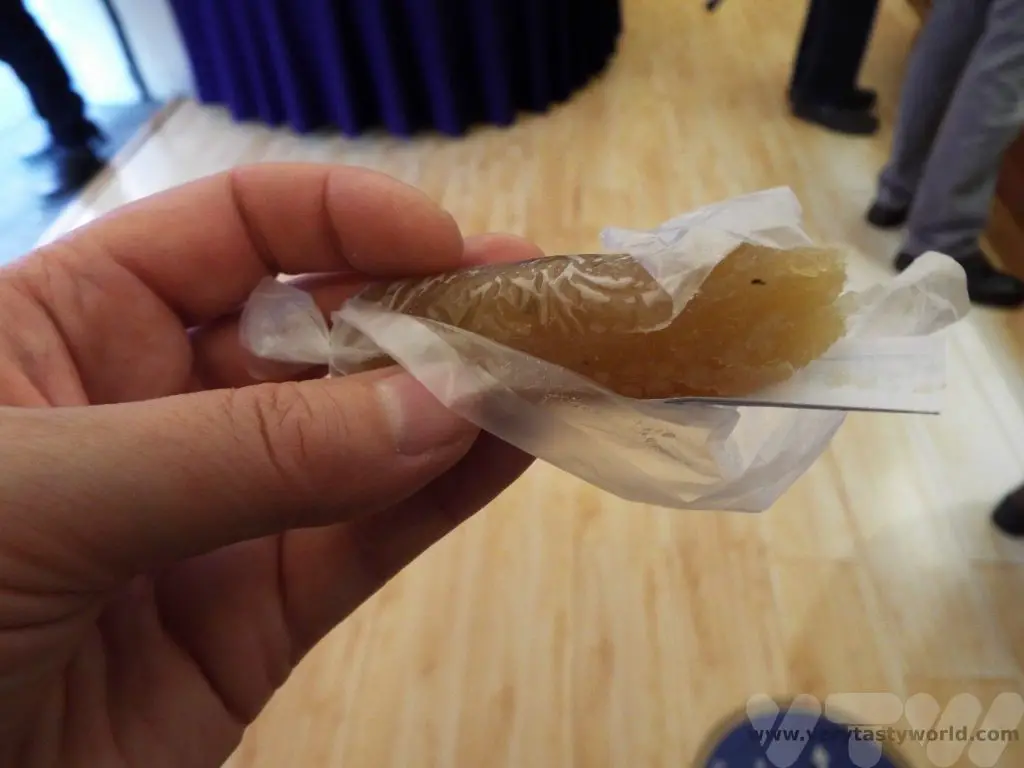
Tortitas de Santa Clara (torte from cake in Spanish) is a delicious fusion of Spanish biscuit base with a filling made from indigenous ground pumpkin seed and honey. A sprinkling of some of the local volcanic salt adds another dimension. This is a nice crumbly biscuit that has a lovely sweetness and smooth peanut butteriness of the pumpkin seeds.
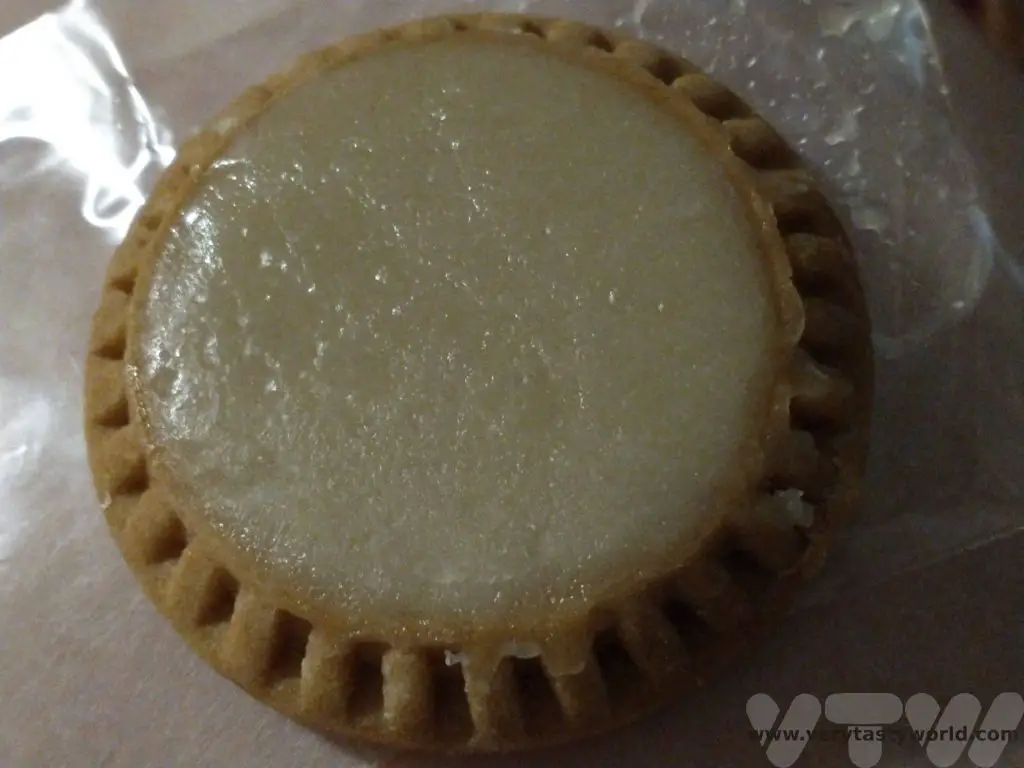
A Magical Market
A short walk out of town, across the road (which used to be the river), took us to Mercado Municipal La Acocota. It was lovely exploring this market, which had so many stalls selling fabulous-looking wares.
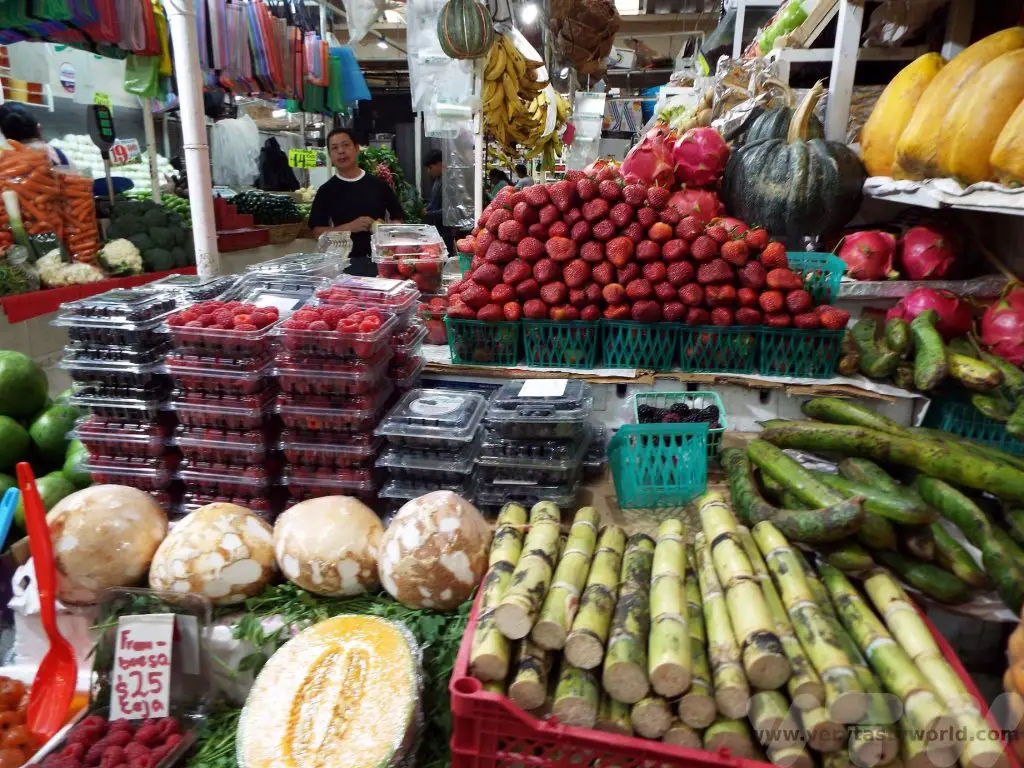
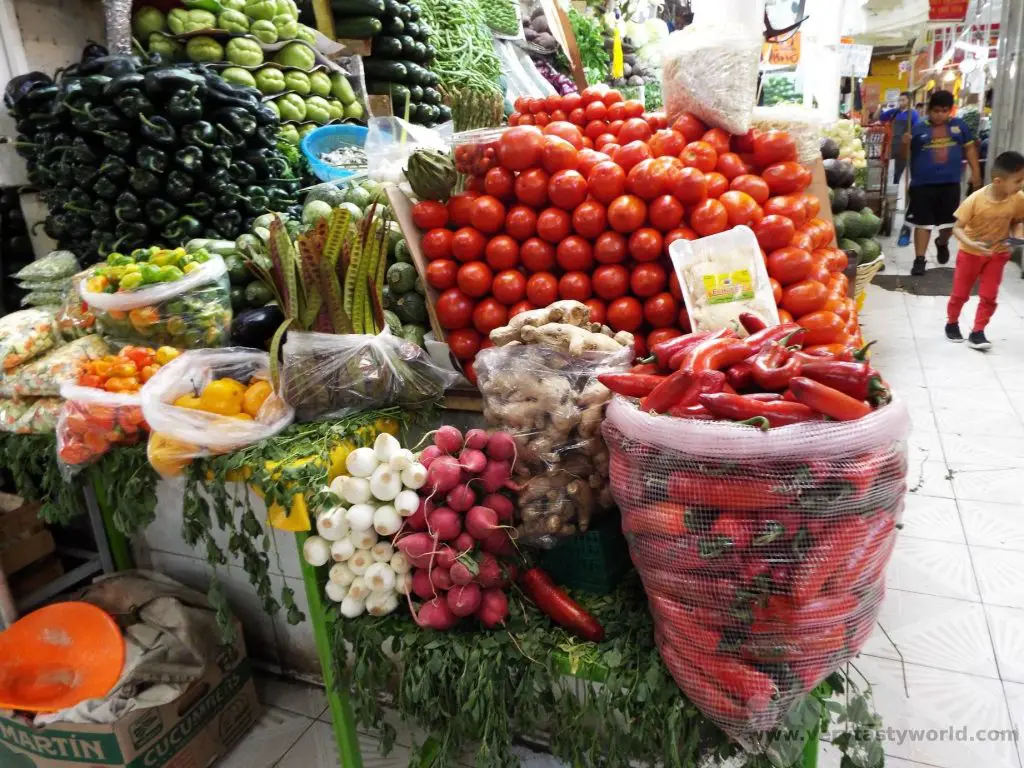
We also discovered the corn mushroom for sale.
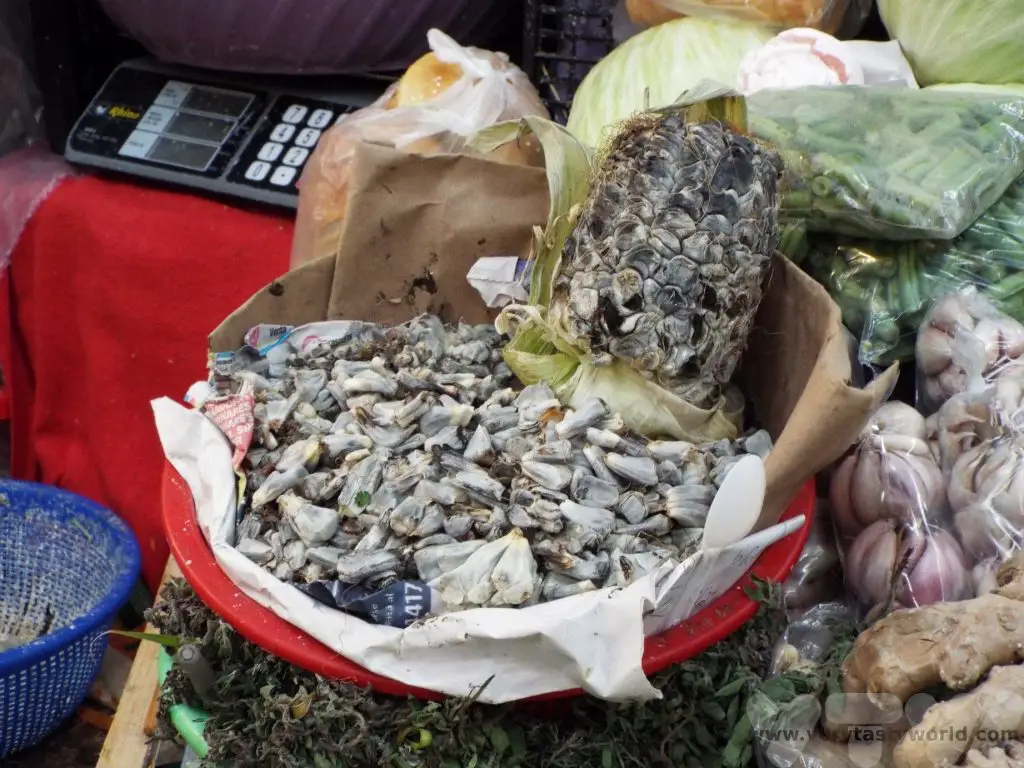
We’ve never seen so many different varieties of chilli pepper!
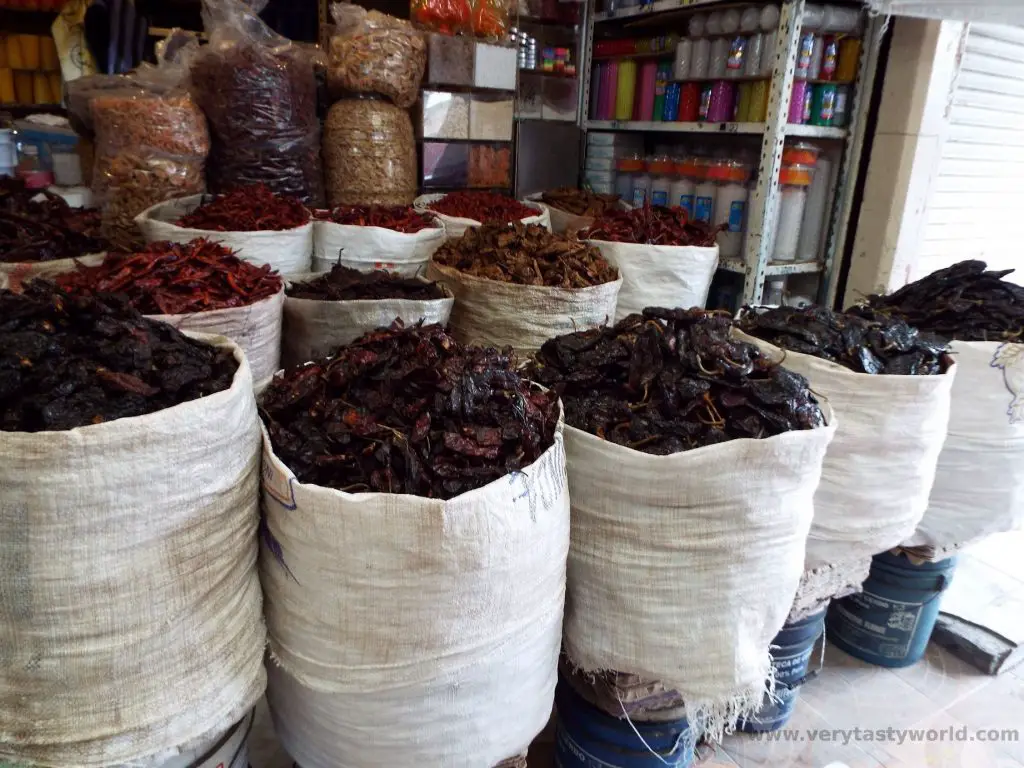
But we weren’t there to shop. We also had plans to eat. You can’t say you’ve been to Puebla unless you have tried a cemita – a massive sandwich of very great deliciousness.
Samita is another family-run business with three generations all working together at the market. They have a fantastic reputation. You sit on stools around the stall and can chat with other customers. Everyone was delightful. The bread is very important in the cemita – it is a wheat-based roll – substantial and fluffy. We enjoyed a Milanese escalope with stringy cheese, jalapeno and avocado.
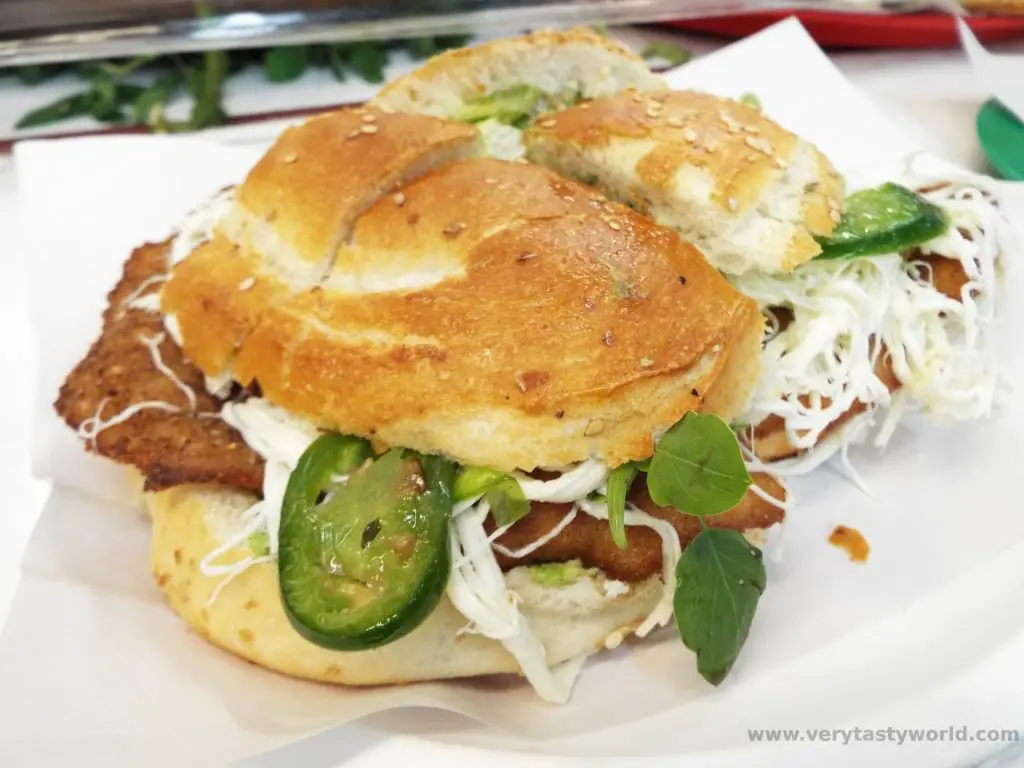
The mega cemita has four fillings including escalope, boiled pork skin, ham, or sliced cheese.
Puebla’s most famous dish is mole (pronounced molay) poblano. It’s another essential dish to try when visiting the area. Over twenty ingredients are used in the most simple mole, including multiple types of chilli, a variety of nuts, and chocolate. The mole at this market is considered to be much more authentic than moles that you will eat at hotels, which are generally more sweet and less spicy. This is where the market stall holders come to eat their lunch – there is always a variety of moles on offer.
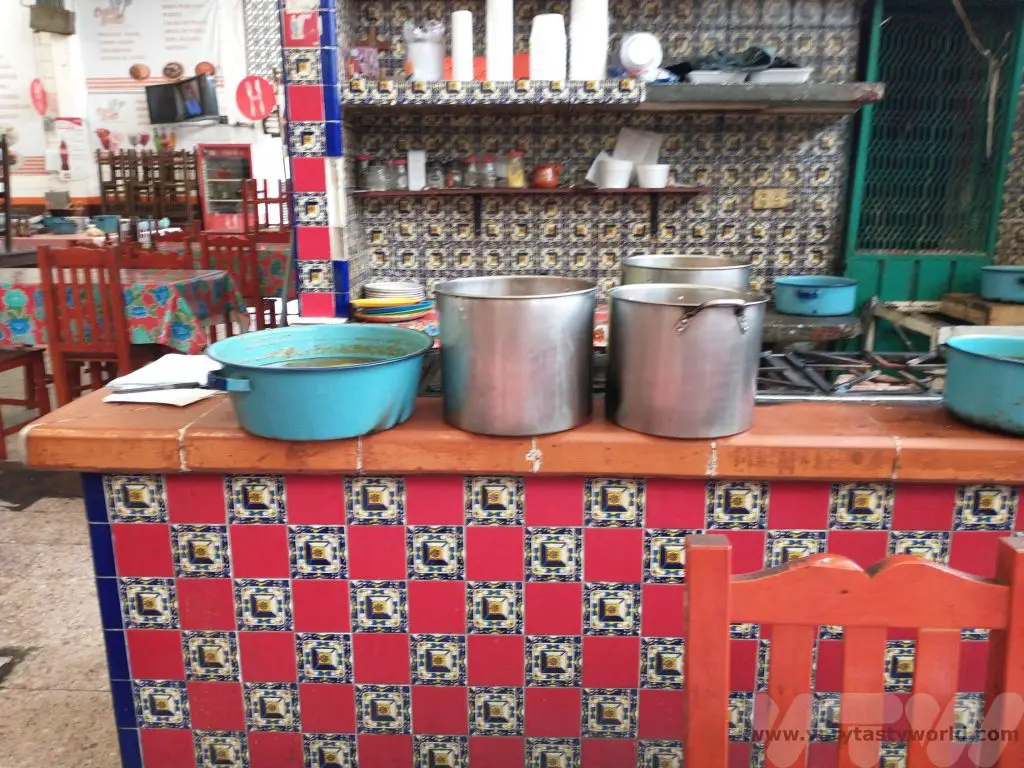
The market’s mole was far more complex and sophisticated. It has a slow burn from the chilli and a mild, but important, bitter element. You get hit by heat in first mouthful but then your mouth gets used to it and can start to savour the other flavours which also include sweetness. This was a rolled tortilla, with no filling, topped with mole sauce, sesame, raw onion and strips of boiled chicken. Simple. Classic.
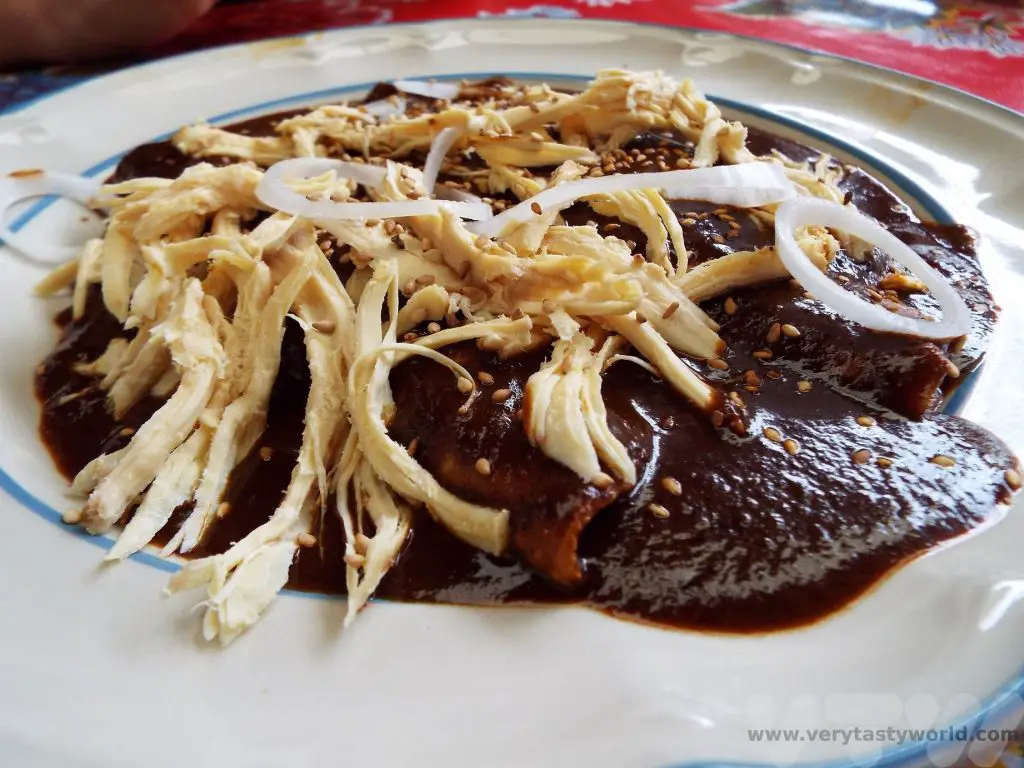
And finally, almost full to bursting point, we stopped off at a local cantina, actually inside an antique shop, where we indulged in a shot of pasita, a liqueur digestif made from raisins.
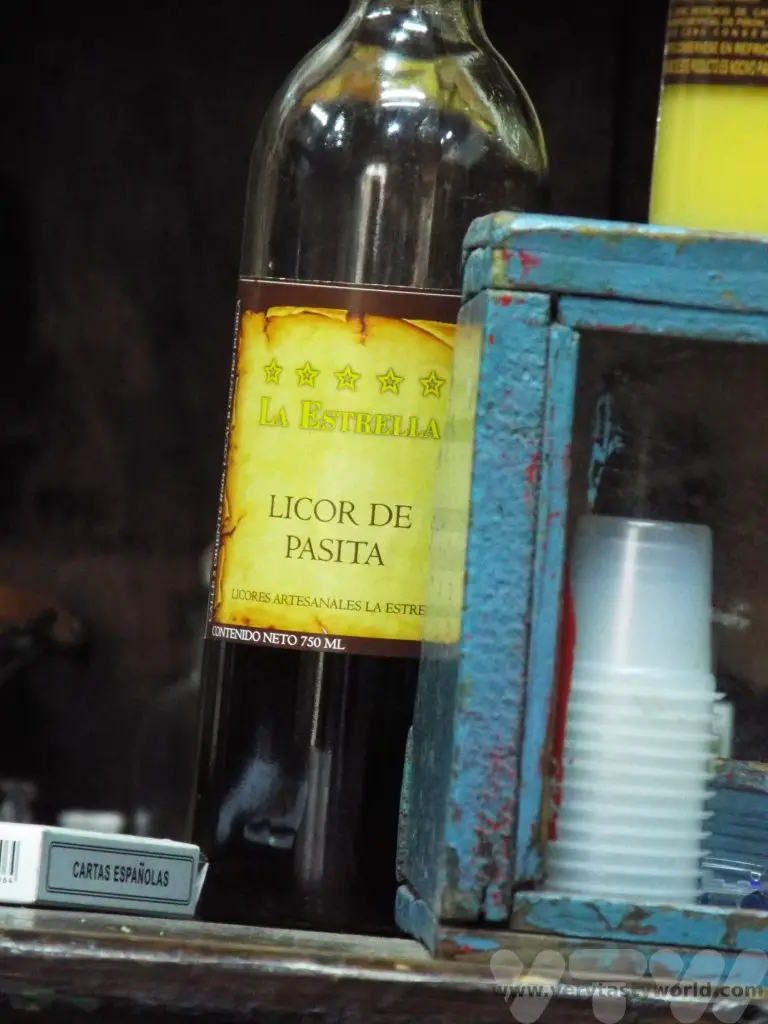
It’s sweet and boozy and rounded off an amazing tour.
Fine Dining
The street food tour of Puebla was a fantastic introduction to this city’s delectable, diverse and delicious cuisine. We also have a restaurant recommendation for local food in a fine dining context (which we visited on a different day to the foodie tour). El Mural de los Poblanos is on Calle 16 de Septiembre and offers typical Puebla food. Again, this mole was more authentic than some of the more touristy establishments.
It’s very popular so it’s definitely worth making a booking. Also, we made the mistake of ordering cemitas as our starters (before we knew what they were) which turned out to be so enormous that we knew we wouldn’t be able to eat our mains if we ate them all, so the staff were very kind and boxed up the extra food for later snacking.
There is also a craft beer emporium, the Bilderberg taproom on Av 5 Ote, which we felt was important to investigate. They offered pints of local draft beer as well as tasting flights. They had a stout which was extremely good indeed, although it was only after we’d quaffed a couple of pints and tried to stand up that we realised that it was 12%! Those leftover cemitas came in handy soaking up the booze later that night to try to mitigate the hangover.
We thoroughly enjoyed our time in Puebla – there was so much to see and do and taste. We’d consider it an essential stop on any Mexico tour. We can’t wait to return!
Related Posts You May Enjoy

- Best Time To Visit Machu Picchu 2024 Update
- A 2 Week Patagonia Itinerary
- Day of the Dead in Campeche
- A Galapagos Land Based Itinerary
- RECIPE: How to Make Costa Rica’s Gallo Pinto
- A Tasty Puebla Food Tour
- Costa Rica Wildlife Sanctuary – Caño Negro
- Visit Torres del Paine National Park in Patagonia
- Atacama Desert Itinerary
